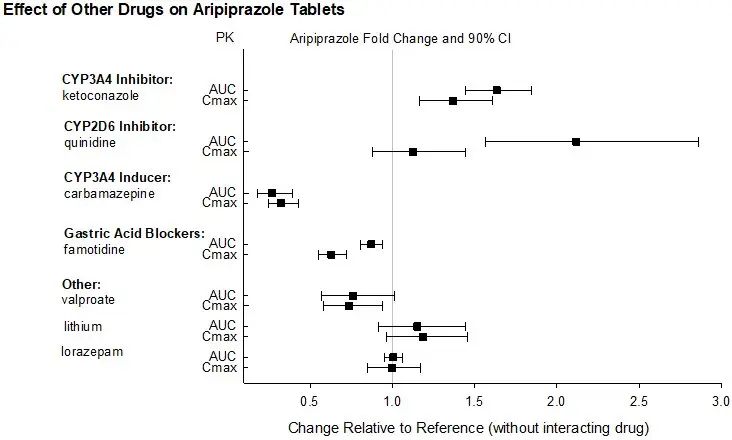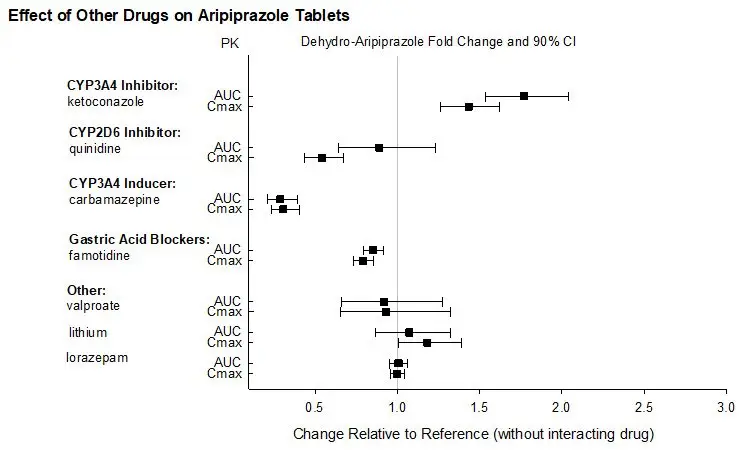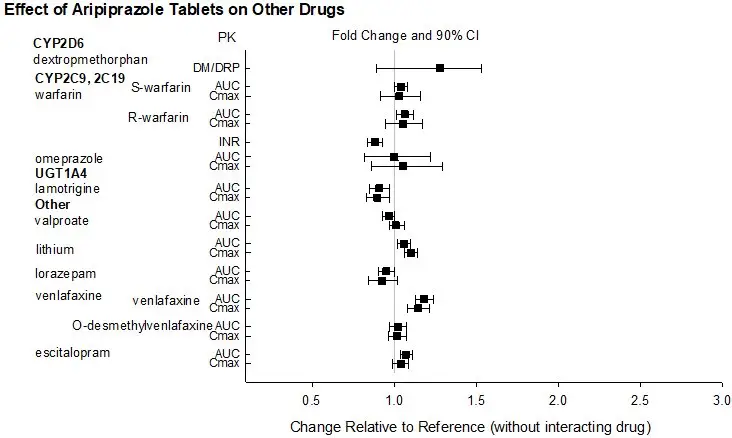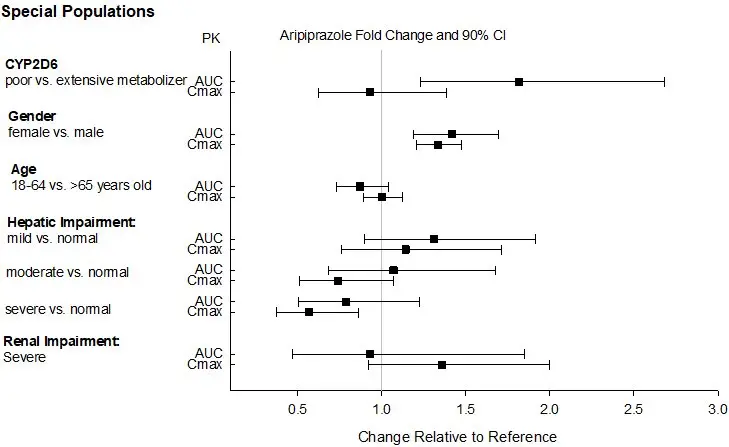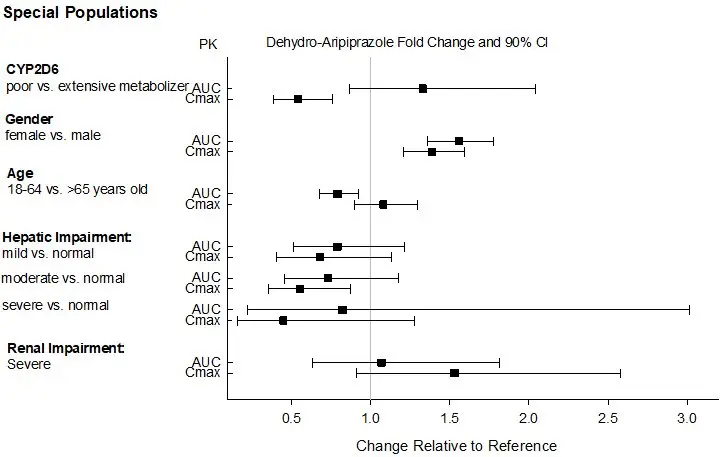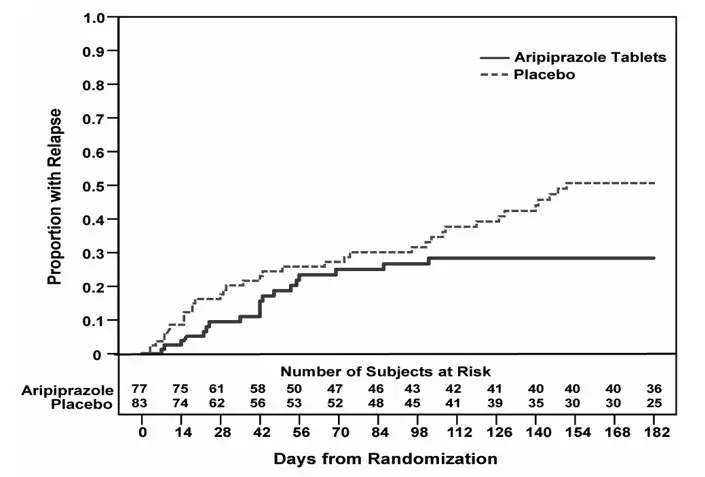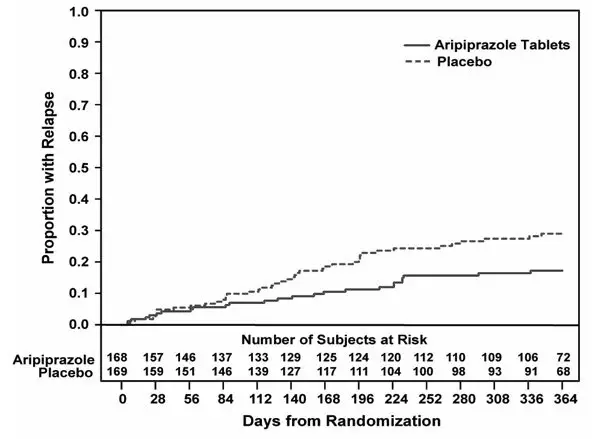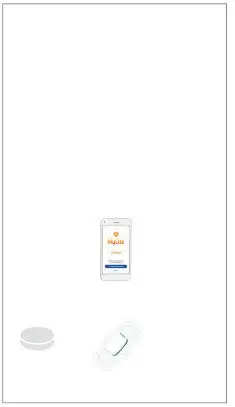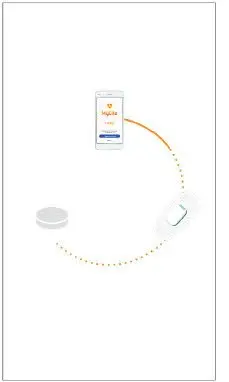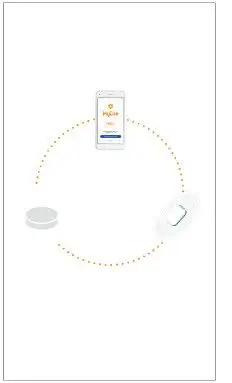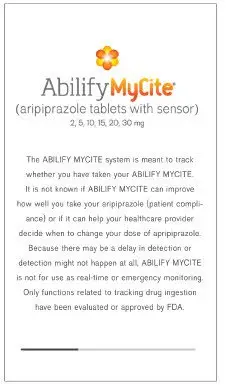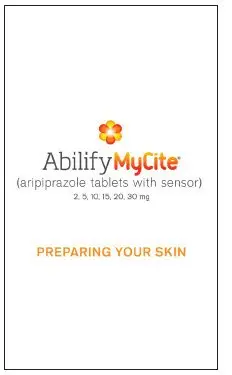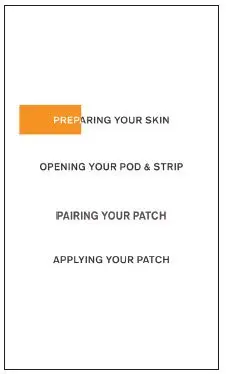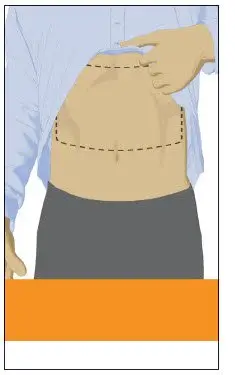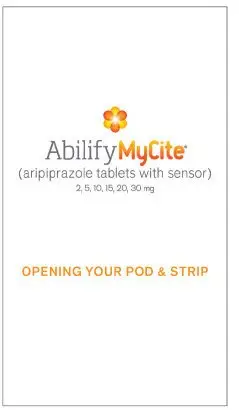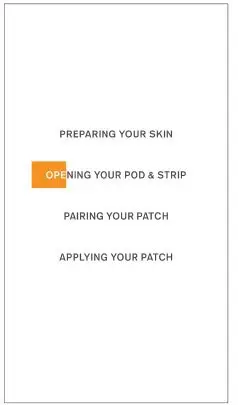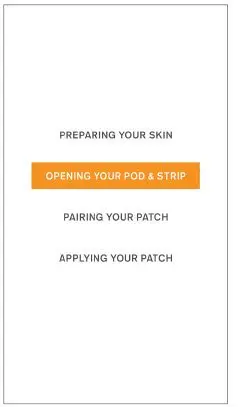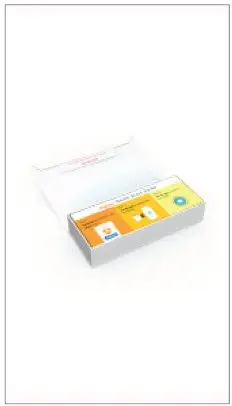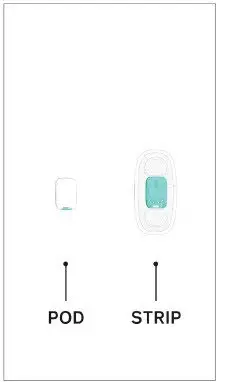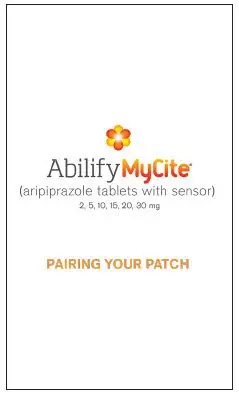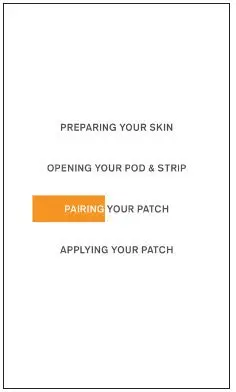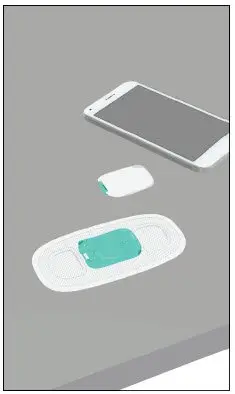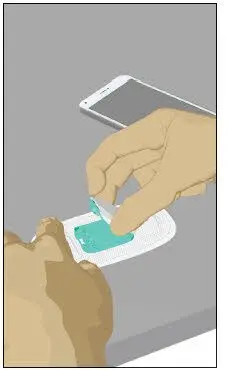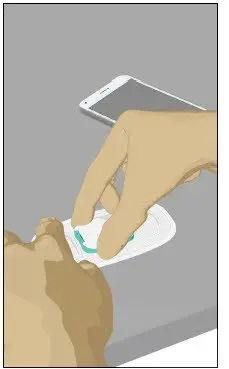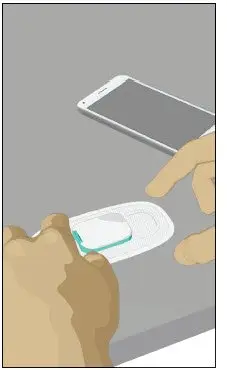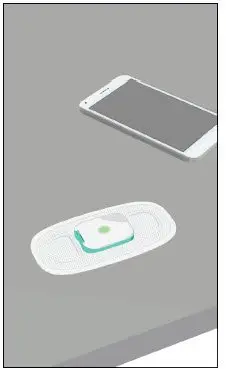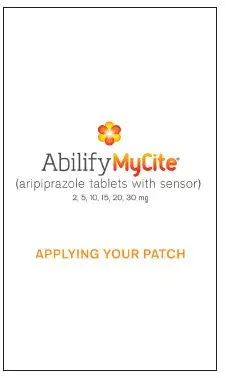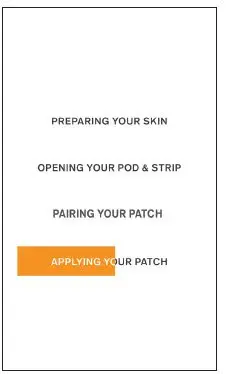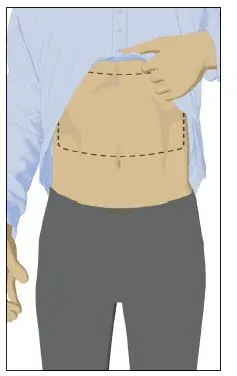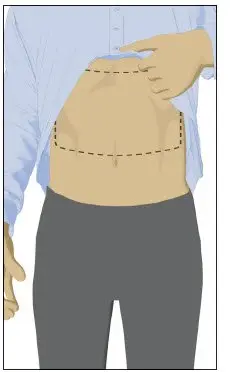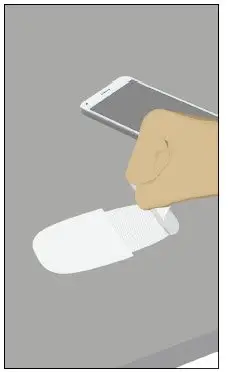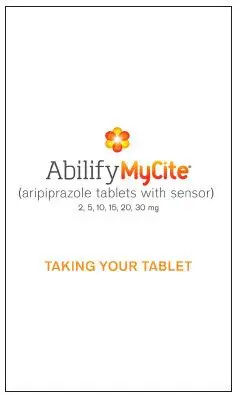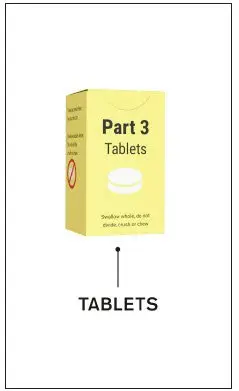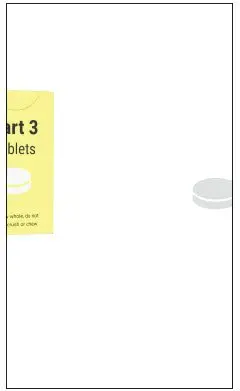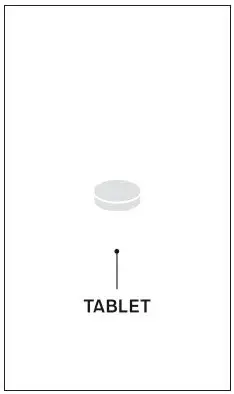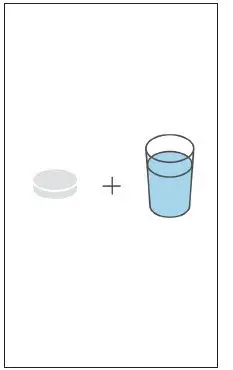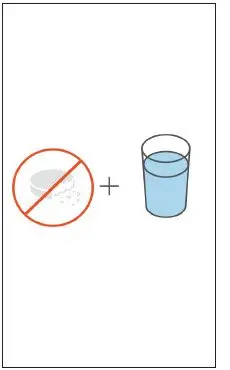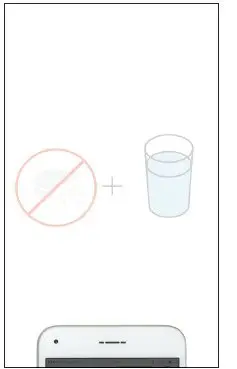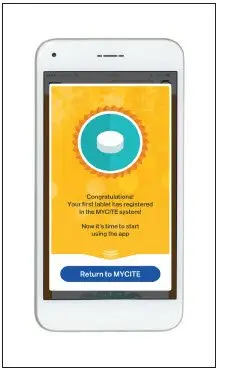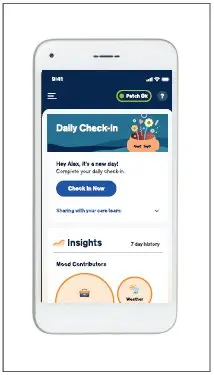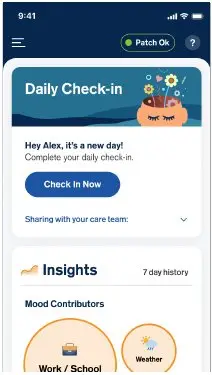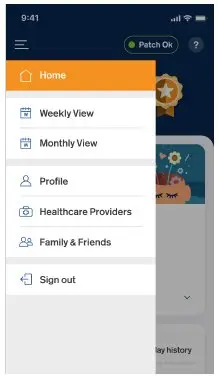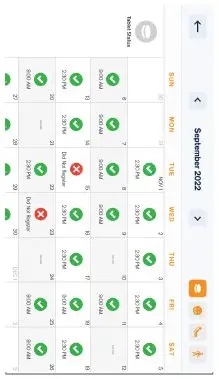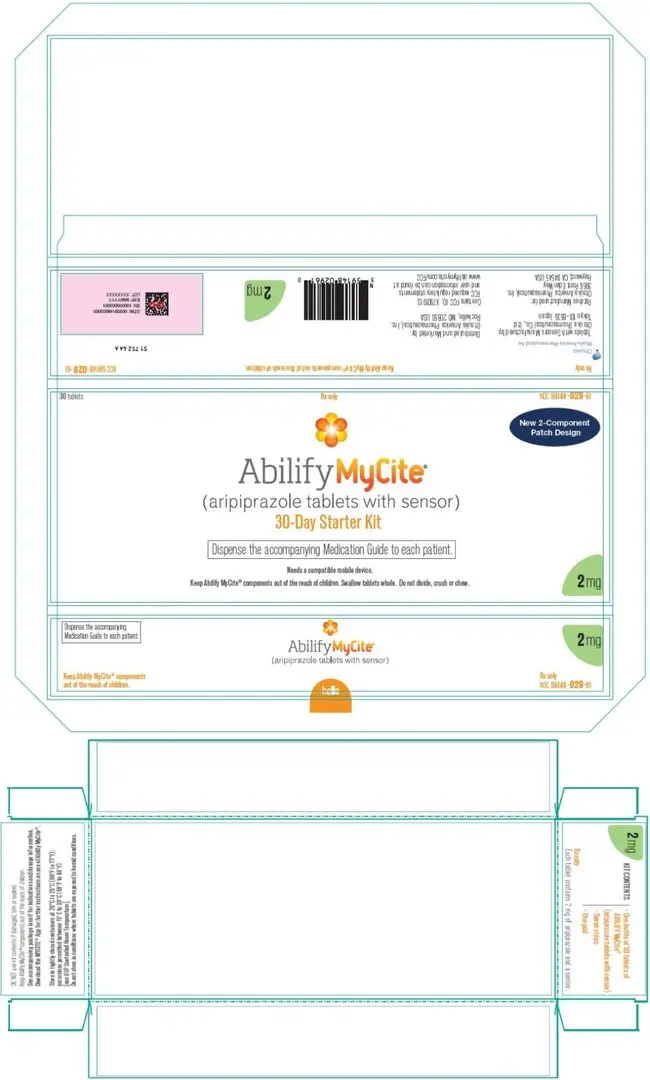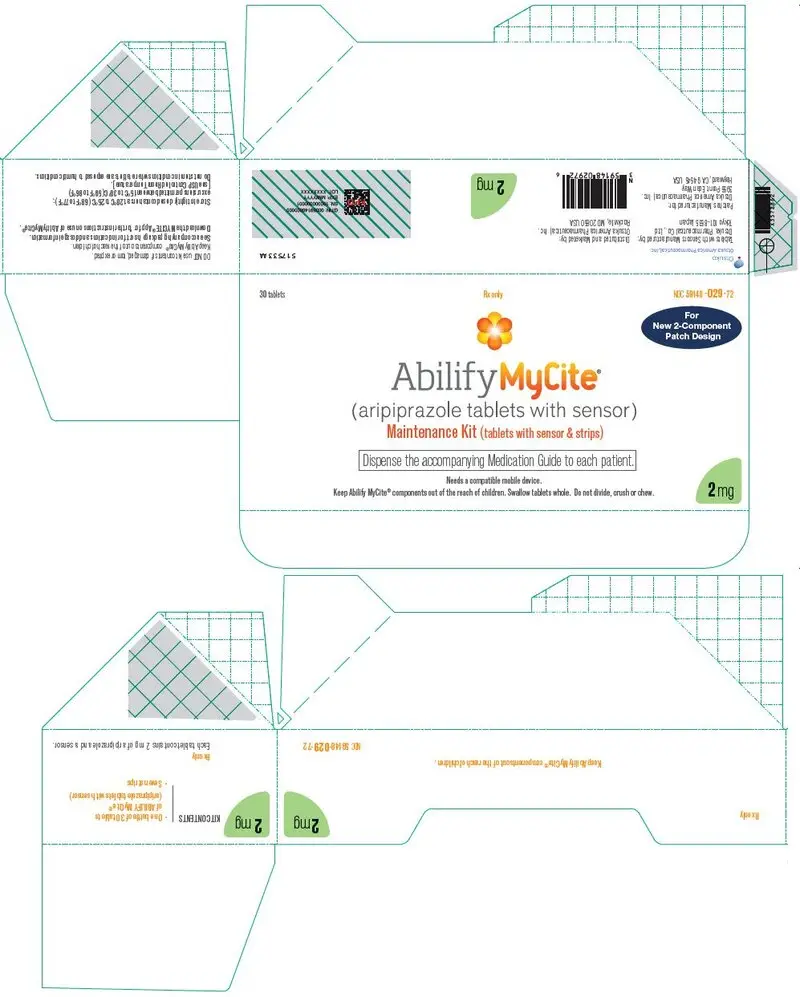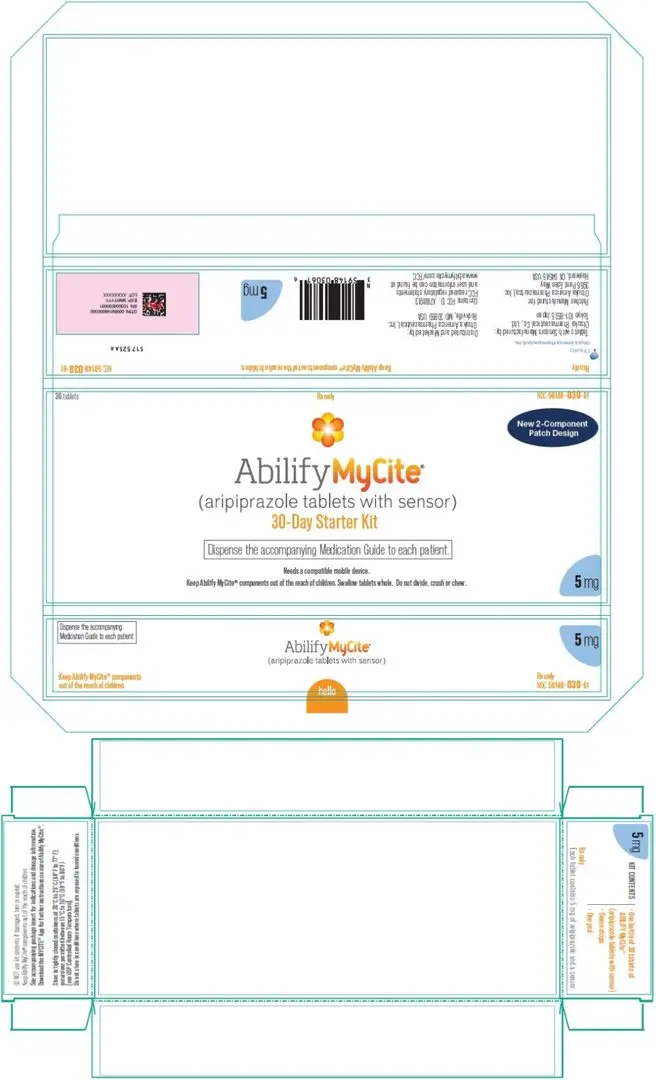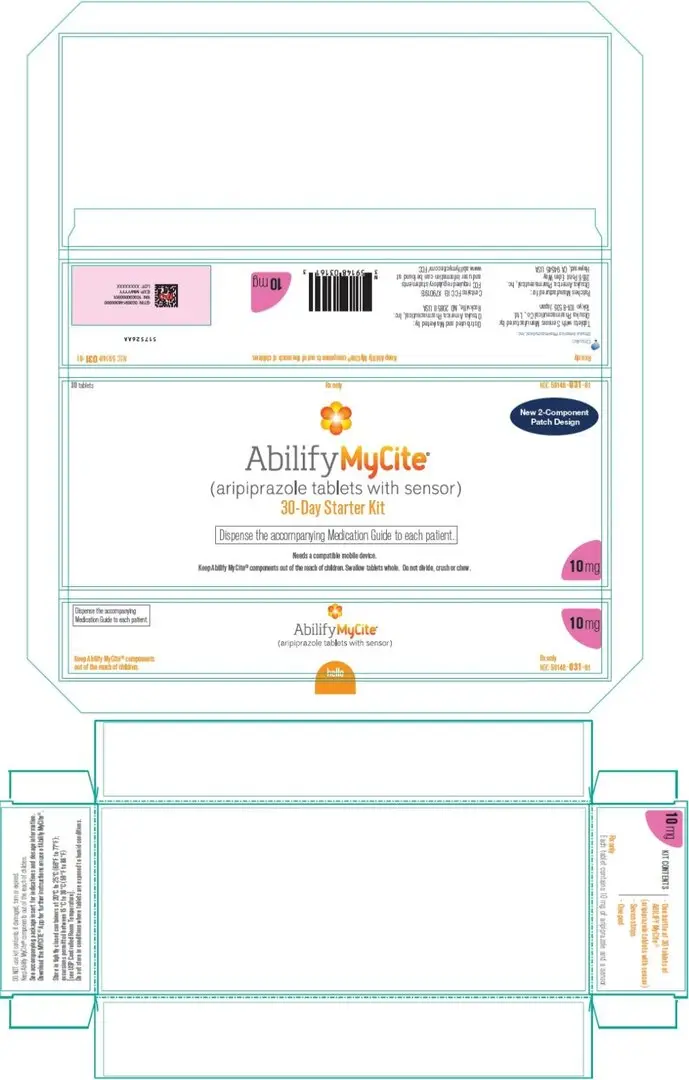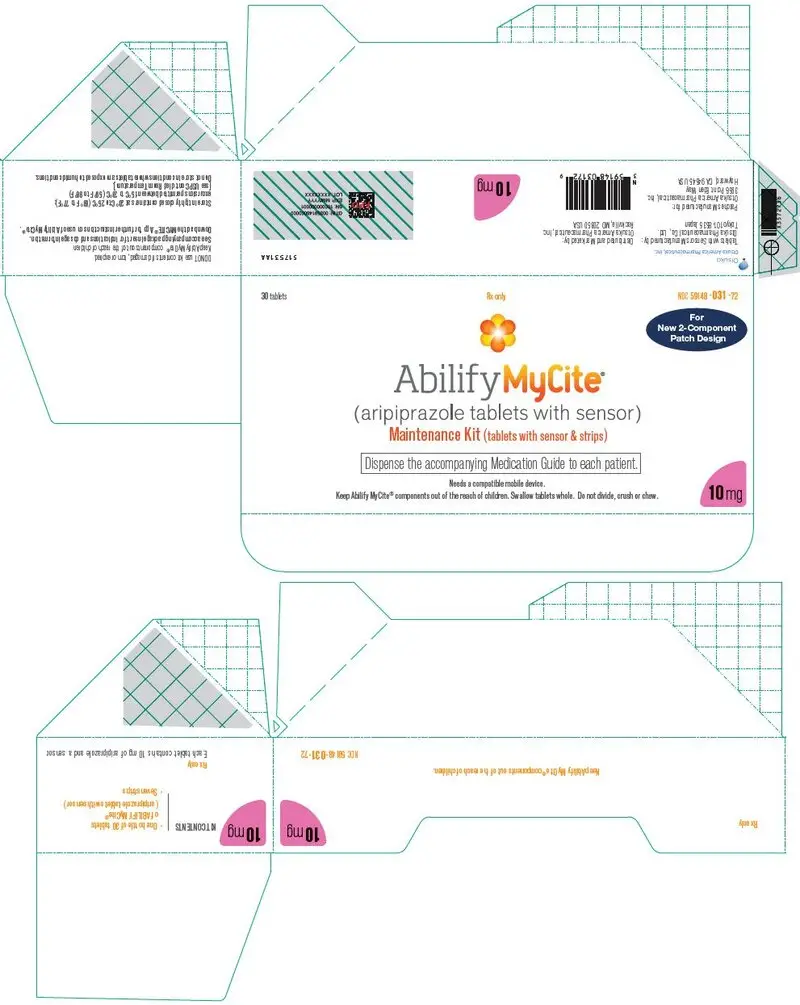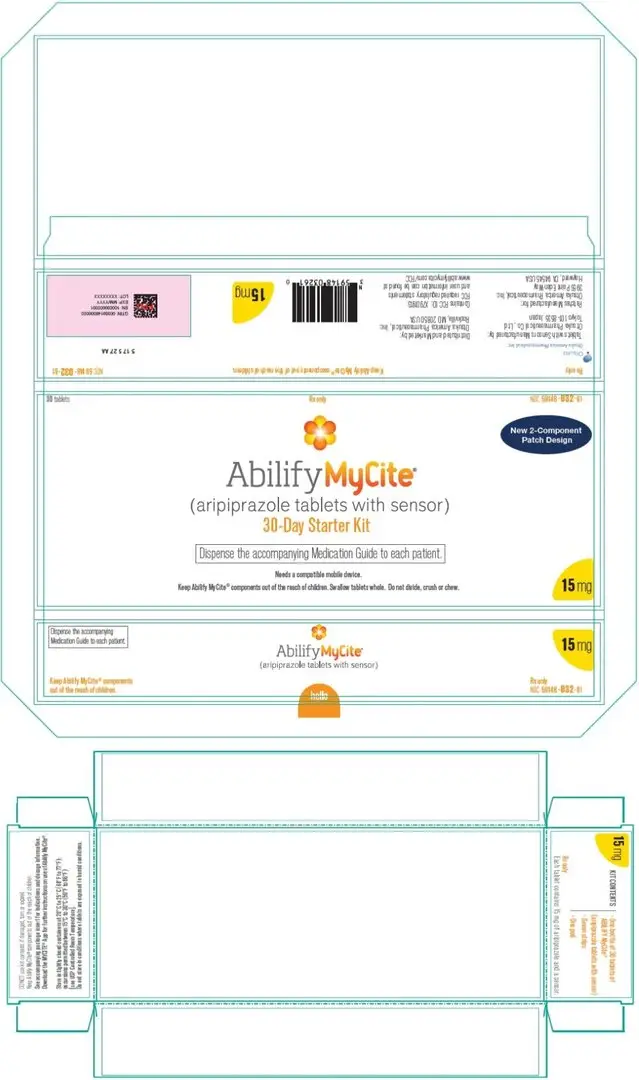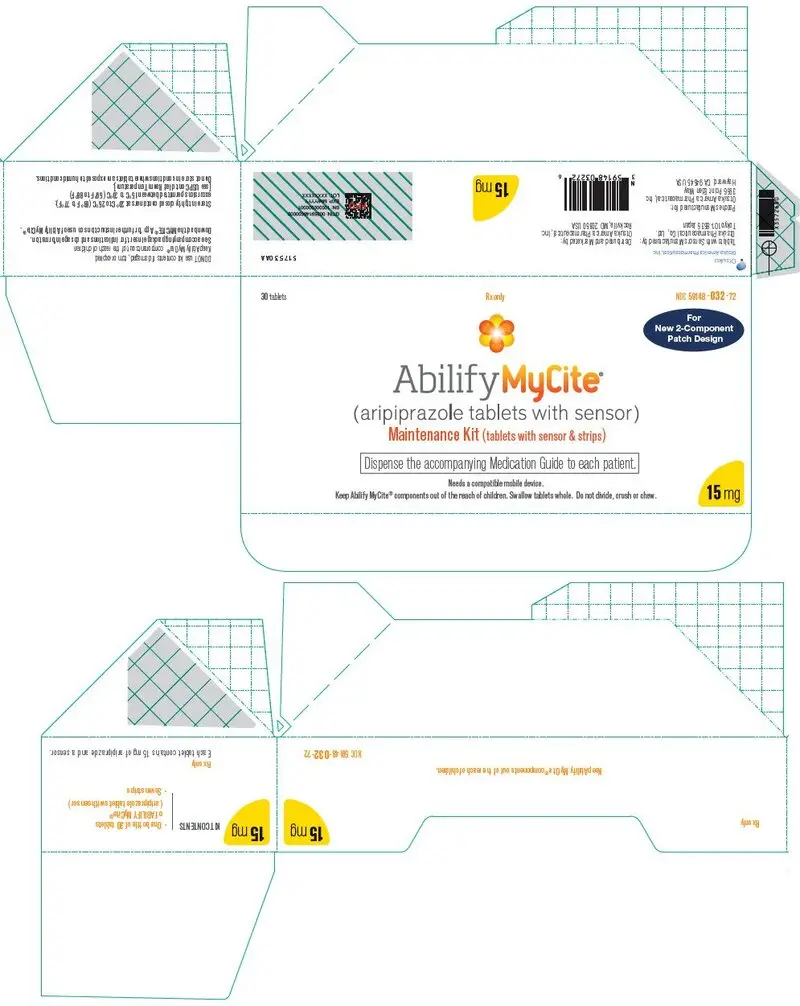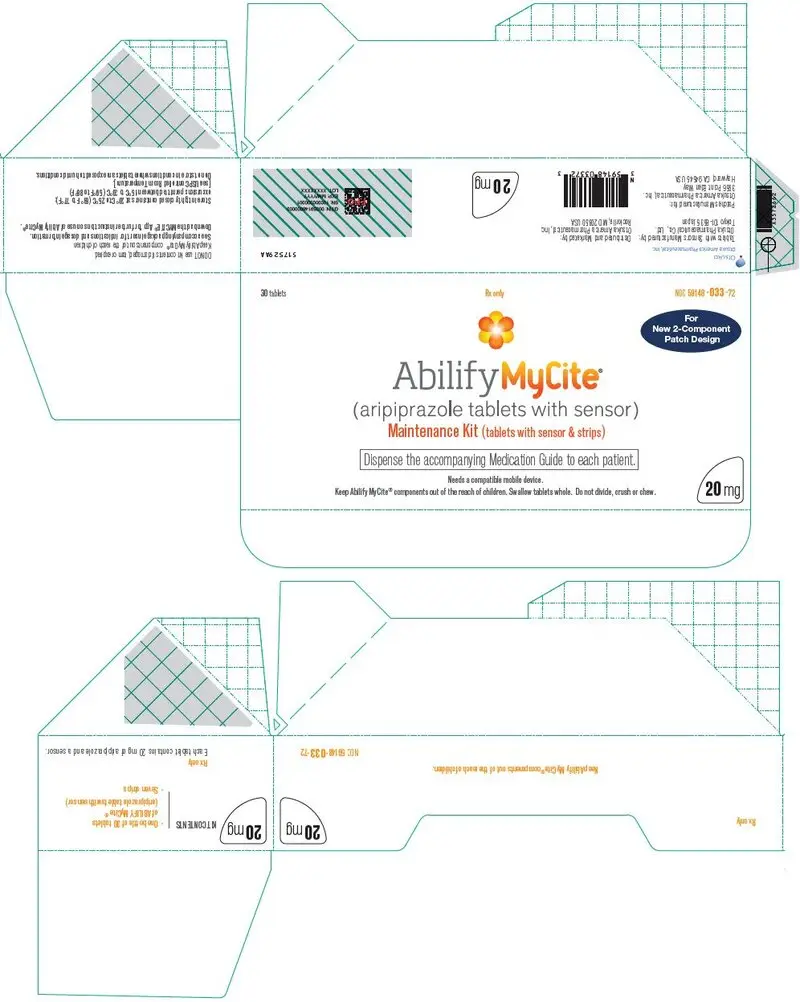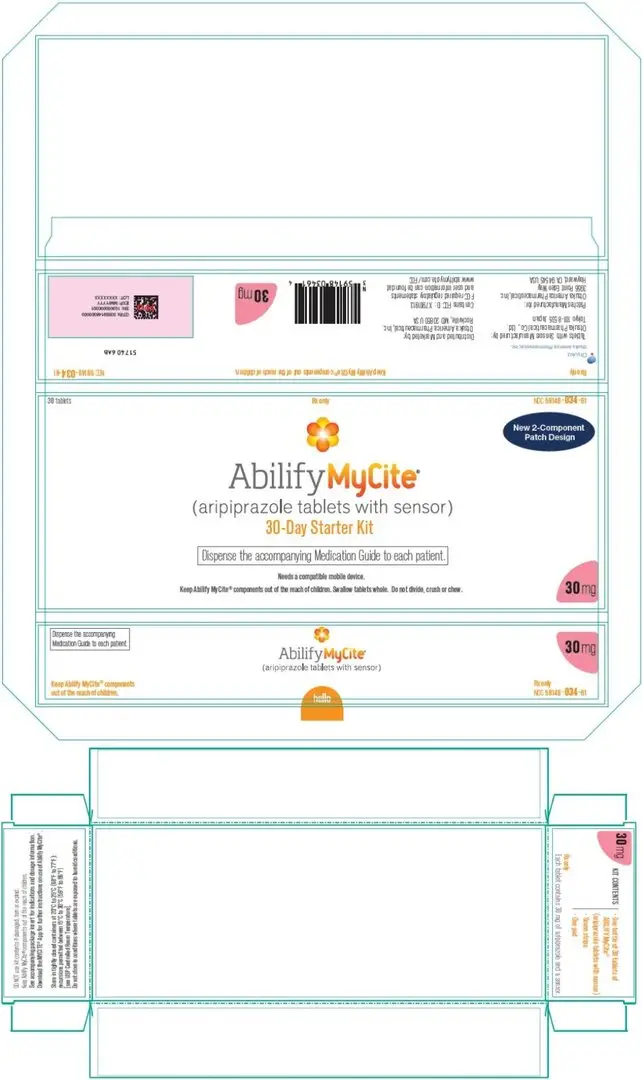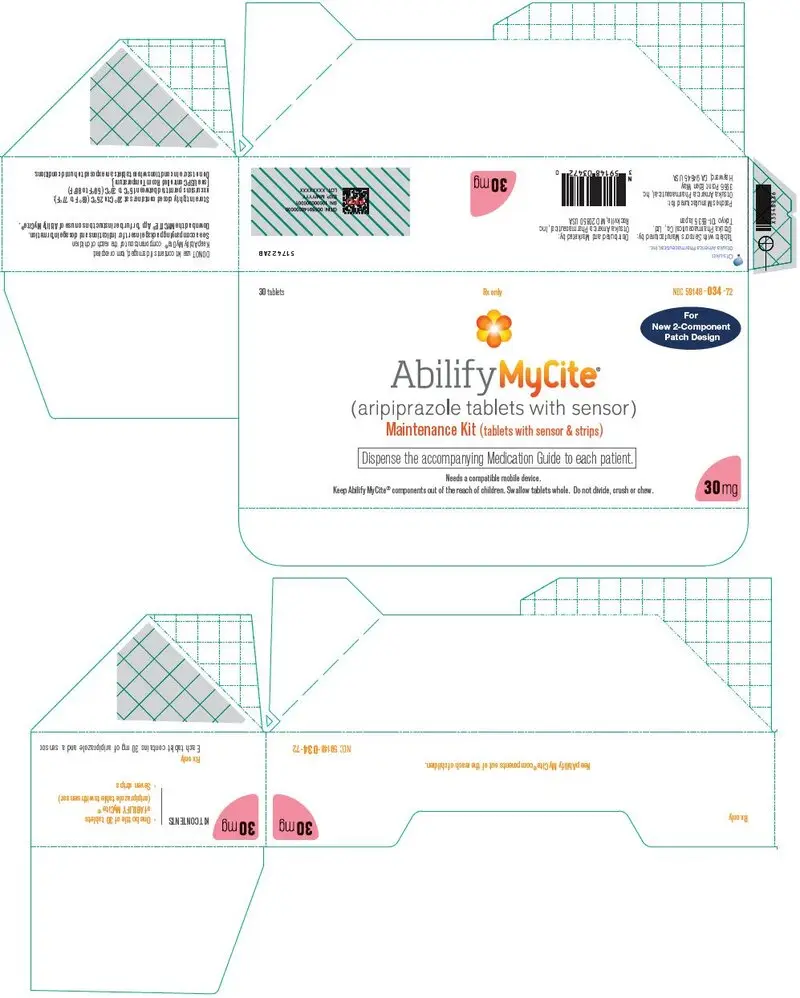Drug Detail:Abilify mycite maintenance kit (oral with sensor) (Aripiprazole (oral with sensor) [ ar-i-pip-ra-zole ])
Drug Class: Atypical antipsychotics
Highlights of Prescribing Information
ABILIFY MYCITE® (aripiprazole tablets with sensor), for oral use
Initial U.S. Approval: 2002
WARNING: INCREASED MORTALITY IN ELDERLY PATIENTS WITH DEMENTIA-RELATED PSYCHOSIS and SUICIDAL THOUGHTS AND BEHAVIORS
See full prescribing information for complete boxed warning.
- Elderly patients with dementia-related psychosis treated with antipsychotic drugs are at an increased risk of death. ABILIFY MYCITE is not approved for the treatment of patients with dementia-related psychosis. (5.1)
- Increased risk of suicidal thoughts and behaviors in pediatric and young adult patients taking antidepressants. Closely monitor for worsening and emergence of suicidal thoughts and behaviors. (5.2)
- The safety and effectiveness of ABILIFY MYCITE have not been established in pediatric patients. (8.4)
Indications and Usage for Abilify Mycite
ABILIFY MYCITE, a drug-device combination product comprised of aripiprazole tablets embedded with an Ingestible Event Marker (IEM) sensor intended to track drug ingestion, is indicated for the:
- Treatment of adults with schizophrenia (1)
- Treatment of bipolar I disorder (1)
- Acute treatment of adults with manic and mixed episodes as monotherapy and as adjunct to lithium or valproate
- Maintenance treatment of adults as monotherapy and as adjunct to lithium or valproate
- Adjunctive treatment of adults with major depressive disorder (MDD) (1)
Limitations of Use:
- The ability of ABILIFY MYCITE to improve patient compliance or modify aripiprazole dosage has not been established. (1)
- The use of ABILIFY MYCITE to track drug ingestion in "real-time" or during an emergency is not recommended because detection may be delayed or not occur. (1)
Abilify Mycite Dosage and Administration
| Initial Dose | Recommended Dose | Maximum Dose | |
|---|---|---|---|
| Schizophrenia – adults (2.3) | 10 to 15 mg/day | 10 to 15 mg/day | 30 mg/day |
| Bipolar mania – adults: monotherapy (2.4) | 15 mg/day | 15 mg/day | 30 mg/day |
| Bipolar mania – adults: adjunct to lithium or valproate (2.4) | 10 to 15 mg/day | 15 mg/day | 30 mg/day |
| Major Depressive Disorder – adults: adjunct to antidepressants (2.5) | 2 to 5 mg/day | 5 to 10 mg/day | 15 mg/day |
- Administer once daily without regard to meals (2.2)
- Swallow whole; do not divide, crush, or chew (2.2)
- Known CYP2D6 poor metabolizers: Administer half of the usual dose (2.6)
Dosage Forms and Strengths
Tablets with sensor: 2 mg, 5 mg, 10 mg, 15 mg, 20 mg, and 30 mg (3)
Contraindications
Known hypersensitivity to aripiprazole tablets (4)
Warnings and Precautions
- Cerebrovascular Adverse Reactions in Elderly Patients with Dementia-Related Psychosis: Increased incidence of cerebrovascular adverse reactions (e.g., stroke, transient ischemic attack, including fatalities) (5.3)
- Neuroleptic Malignant Syndrome: Manage with immediate discontinuation and close monitoring (5.4)
- Tardive Dyskinesia: Discontinue if clinically appropriate (5.5)
- Metabolic Changes: Monitor for hyperglycemia/diabetes mellitus, dyslipidemia, and weight gain (5.6)
- Pathological Gambling and other Compulsive Behaviors: Consider dose reduction or discontinuation (5.7)
- Orthostatic Hypotension: Monitor heart rate and blood pressure and warn patients with known cardiovascular or cerebrovascular disease, and risk of dehydration or syncope (5.8)
- Leukopenia, Neutropenia, and Agranulocytosis: Perform complete blood cell counts in patients with a history of a clinically significant low white blood cell count (WBC)/absolute neutrophil count (ANC). Consider discontinuation if clinically significant decline in WBC/ANC in the absence of other causative factors (5.10)
- Seizures: Use cautiously in patients with a history of seizures or with conditions that lower the seizure threshold (5.11)
- Potential for Cognitive and Motor Impairment: Use caution when operating machinery (5.12)
Adverse Reactions/Side Effects
Commonly observed adverse reactions (incidence ≥5% and at least twice that for placebo) in adult patients (6.1):
- Schizophrenia: akathisia
- Bipolar mania (monotherapy): akathisia, sedation, restlessness, tremor, and extrapyramidal disorder
- Bipolar mania (adjunctive therapy with lithium or valproate): akathisia, insomnia, and extrapyramidal disorder
- MDD (adjunctive treatment to antidepressant therapy): akathisia, restlessness, insomnia, constipation, fatigue, and blurred vision
To report SUSPECTED ADVERSE REACTIONS, contact Otsuka America Pharmaceutical, Inc. at 1-800-438-9927 or FDA at 1-800-FDA-1088 or www.fda.gov/medwatch.
Drug Interactions
Dosage adjustment due to drug interactions and CYP2D6 poor metabolizers (7.1):
| Factors | Dosage Adjustments for ABILIFY MYCITE |
|---|---|
| Known CYP2D6 Poor Metabolizers | Administer half recommended dose |
| Known CYP2D6 Poor Metabolizers and strong CYP3A4 inhibitors | Administer a quarter of recommended dose |
| Strong CYP2D6 or CYP3A4 inhibitors | Administer half recommended dose |
| Strong CYP2D6 and CYP3A4 inhibitors | Administer a quarter of recommended dose |
| Strong CYP3A4 inducers | Double recommended dose over 1 to 2 weeks |
Use In Specific Populations
Pregnancy: May cause extrapyramidal and/or withdrawal symptoms in neonates with third trimester exposure (8.1)
See 17 for PATIENT COUNSELING INFORMATION and Medication Guide.
Revised: 2/2023
Related/similar drugs
Rexulti, Trintellix, Vraylar, Caplyta, sertraline, trazodone, LexaproFull Prescribing Information
WARNING: INCREASED MORTALITY IN ELDERLY PATIENTS WITH DEMENTIA-RELATED PSYCHOSIS and SUICIDAL THOUGHTS AND BEHAVIORS
1. Indications and Usage for Abilify Mycite
ABILIFY MYCITE, a drug-device combination product comprised of aripiprazole tablets embedded with an Ingestible Event Marker (IEM) sensor intended to track drug ingestion, is indicated for the:
- Treatment of adults with schizophrenia.
- Treatment of bipolar I disorder
- Acute treatment of adults with manic and mixed episodes as monotherapy and as adjunct to lithium or valproate.
- Maintenance treatment of adults as monotherapy and as adjunct to lithium or valproate.
- Adjunctive treatment of adults with Major Depressive Disorder.
2. Abilify Mycite Dosage and Administration
2.1 Overview of the ABILIFY MYCITE System
The ABILIFY MYCITE System is composed of the following:
- Aripiprazole tablet embedded with an IEM sensor (ABILIFY MYCITE);
- MYCITE® Patch (wearable sensor) that detects the signal from the IEM sensor after ingestion and transmits data to a smartphone (referred to as the patch);
- MYCITE App - a smartphone application which is used with a compatible smartphone to display information for the patient (referred to as the app);
- Web-based portal for healthcare professionals and caregivers
Prior to initial patient use of the ABILIFY MYCITE System, facilitate use of ABILIFY MYCITE and the patch, app, and portal; ensure the patient is capable and willing to use a smartphone and the app; and instruct patients to [see How Supplied/Storage and Handling (16.1)]:
- Download the app,
- Follow all the instructions in the Instructions for Use within the app and the Quick Start Guide within the carton, and
- Ensure that the app is compatible with their specific smartphone and is paired with the patch prior to use.
Prior to prescribing the ABILIFY MYCITE Maintenance Kit ensure the patient has access to the appropriate components of the patch [see How Supplied/Storage and Handling (16.1)].
Although most ingestions will be detected within 30 minutes, it may take up to two hours for the app and portal to detect the ingestion of ABILIFY MYCITE; in some cases, the ingestion of the tablet with sensor may not be detected. If the tablet with sensor is not detected after ingestion, do not repeat the dose [see Adverse Reactions (6)].
2.2 Administration Instructions
2.3 Dosage in Schizophrenia
The recommended starting and target dosage for ABILIFY MYCITE in adults with schizophrenia is 10 or 15 mg daily. Dosage increases should generally not be made before 2 weeks [see Clinical Pharmacology (12.3)]. The maximum recommended dosage is 30 mg daily; however, doses above 15 mg daily have shown no additional clinically meaningful benefit.
2.4 Dosage in Bipolar I Disorder
The recommended starting dosage in adults with acute and mixed episodes associated with bipolar I disorder is 15 mg given once daily as monotherapy and 10 mg to 15 mg given once daily as adjunctive treatment with lithium or valproate. The recommended target dose of ABILIFY MYCITE is 15 mg daily, as monotherapy or as adjunctive treatment with lithium or valproate. The dosage may be increased to 30 mg daily based on clinical response. The maximum recommended daily dosage is 30 mg.
2.5 Dosage in Adjunctive Treatment of Major Depressive Disorder
The recommended starting dose for ABILIFY MYCITE as adjunctive treatment of adults with MDD taking an antidepressant is 2 to 5 mg daily. The recommended dosage range is 2 to 15 mg daily. Dosage adjustments of up to 5 mg daily should occur gradually, at intervals of no less than one week. The maximum recommended daily dosage is 15 mg. Periodically reassess to determine the continued need for maintenance treatment.
2.6 Dosage Adjustments for Cytochrome P450 Considerations
Dosage adjustments are recommended in patients who are known CYP2D6 poor metabolizers and in patients taking concomitant CYP3A4 inhibitors or CYP2D6 inhibitors or strong CYP3A4 inducers (see Table 1). When the coadministered drug is withdrawn from the combination therapy, ABILIFY MYCITE dosage should then be adjusted to its original level. When the coadministered CYP3A4 inducer is withdrawn, ABILIFY MYCITE dosage should be reduced to the original level over 1 to 2 weeks. Patients who may be receiving a combination of strong, moderate, and weak inhibitors of CYP3A4 and CYP2D6 (e.g., a strong CYP3A4 inhibitor and a moderate CYP2D6 inhibitor or a moderate CYP3A4 inhibitor with a moderate CYP2D6 inhibitor), the dosing may be reduced to one-quarter (25%) of the usual dose initially and then adjusted based on clinical response.
| Factors | Dosage Adjustments for ABILIFY MYCITE |
|---|---|
| Known CYP2D6 Poor Metabolizers | Administer half of recommended dose |
| Known CYP2D6 Poor Metabolizers taking concomitant strong CYP3A4 inhibitors (e.g., itraconazole, clarithromycin) | Administer a quarter of recommended dose |
| Strong CYP2D6 (e.g., quinidine, fluoxetine, paroxetine) or CYP3A4 inhibitors (e.g., itraconazole, clarithromycin) | Administer half of recommended dose |
| Strong CYP2D6 and CYP3A4 inhibitors | Administer a quarter of recommended dose |
| Strong CYP3A4 inducers (e.g., carbamazepine, rifampin) | Double recommended dose over 1 to 2 weeks |
When adjunctive ABILIFY MYCITE is administered to patients with major depressive disorder, ABILIFY MYCITE should be administered without dosage adjustment as specified in [Dosage and Administration (2.5)].
3. Dosage Forms and Strengths
ABILIFY MYCITE (aripiprazole tablets with sensor) is available as described in Table 2.
| Strength | Color/Shape | Markings |
|---|---|---|
| 2 mg | pale green modified rectangle | "DA-029" and "2" |
| 5 mg | pale blue modified rectangle | "DA-030" and "5" |
| 10 mg | off-white to pale pink modified rectangle | "DA-031" and "10" |
| 15 mg | pale yellow round | "DA-032" and "15" |
| 20 mg | white to pale yellowish white round | "DA-033" and "20" |
| 30 mg | off-white to pale pink round | "DA-034" and "30" |
4. Contraindications
ABILIFY MYCITE is contraindicated in patients with a history of a hypersensitivity reaction to aripiprazole. Reactions have ranged from pruritus/urticaria to anaphylaxis [see Adverse Reactions (6.2)].
5. Warnings and Precautions
5.1 Increased Mortality in Elderly Patients with Dementia-Related Psychosis
Elderly patients with dementia-related psychosis treated with antipsychotic drugs are at an increased risk of death. Analyses of 17 placebo-controlled trials (modal duration of 10 weeks), largely in patients taking atypical antipsychotic drugs, revealed a risk of death in drug-treated patients of between 1.6 to 1.7 times the risk of death in placebo-treated patients. Over the course of a typical 10-week controlled trial, the rate of death in drug-treated patients was about 4.5%, compared to a rate of about 2.6% in the placebo group.
Although the causes of death were varied, most of the deaths appeared to be either cardiovascular (e.g., heart failure, sudden death) or infectious (e.g., pneumonia) in nature. Observational studies suggest that, similar to atypical antipsychotic drugs, treatment with conventional antipsychotic drugs may increase mortality. The extent to which the findings of increased mortality in observational studies may be attributed to the antipsychotic drug as opposed to some characteristic(s) of the patients is not clear. ABILIFY MYCITE is not approved for the treatment of patients with dementia-related psychosis [see Boxed Warning, and Warnings and Precautions (5.3)].
5.2 Suicidal Thoughts and Behaviors in Pediatric and Young Adult Patients
In pooled analyses of placebo-controlled trials of antidepressant drugs (SSRIs and other antidepressant classes) that included approximately 77,000 adult patients and over 4,400 pediatric patients, the incidence of suicidal thoughts and behaviors in pediatric and young adult patients was greater in antidepressant-treated patients than in placebo-treated patients. The safety and efficacy of ABILIFY MYCITE have not been established in pediatric patients [see Use in Specific Populations (8.4)]. The drug-placebo differences in the number of cases of suicidal thoughts and behaviors per 1000 patients treated are provided in Table 3.
No suicides occurred in any of the pediatric studies. There were suicides in the adult studies, but the number was not sufficient to reach any conclusion about antidepressant drug effect on suicide.
| Age Range (years) | Drug-Placebo Difference in Number of Patients with Suicidal Thoughts or Behaviors per 1000 Patients Treated |
|---|---|
| Increases Compared to Placebo | |
| <18 | 14 additional patients |
| 18 to 24 | 5 additional patients |
| Decreases Compared to Placebo | |
| 25 to 64 | 1 fewer patient |
| ≥65 | 6 fewer patients |
It is unknown whether the risk of suicidal thoughts and behaviors in pediatric and young adult patients extends to longer-term use, i.e., beyond four months. However, there is substantial evidence from placebo-controlled maintenance trials in adults with MDD that antidepressants delay the recurrence of depression.
Monitor all antidepressant-treated patients for clinical worsening and emergence of suicidal thoughts and behaviors, especially during the initial few months of drug therapy and at times of dosage changes. Counsel family members or caregivers of patients to monitor for changes in behavior and to alert the healthcare provider. Consider changing the therapeutic regimen, including possibly discontinuing ABILIFY MYCITE, in patients whose depression is persistently worse, or who are experiencing emergent suicidal thoughts or behaviors.
5.3 Cerebrovascular Adverse Reactions, Including Stroke, in Elderly Patients with Dementia-Related Psychosis
In placebo-controlled clinical studies (two flexible-dose and one fixed-dose study) of dementia-related psychosis, there was an increased incidence of cerebrovascular adverse events (e.g., stroke, transient ischemic attack), including fatalities, in aripiprazole-treated patients (mean age: 84 years; range: 78 to 88 years). In the fixed-dose study, there was a statistically significant dose-response relationship for cerebrovascular adverse events in patients treated with aripiprazole. ABILIFY MYCITE is not approved for the treatment of patients with dementia-related psychosis [see Boxed Warning].
5.4 Neuroleptic Malignant Syndrome (NMS)
A potentially fatal symptom complex sometimes referred to as Neuroleptic Malignant Syndrome (NMS) may occur with administration of antipsychotic drugs, including ABILIFY MYCITE. Clinical manifestations of NMS are hyperpyrexia, muscle rigidity, altered mental status, and evidence of autonomic instability (irregular pulse or blood pressure, tachycardia, diaphoresis, and cardiac dysrhythmia). Additional signs may include elevated creatine phosphokinase, myoglobinuria (rhabdomyolysis), and acute renal failure.
The diagnostic evaluation of patients with this syndrome is complicated. In arriving at a diagnosis, it is important to exclude cases where the clinical presentation includes both serious medical illness (e.g., pneumonia, systemic infection) and untreated or inadequately treated extrapyramidal signs and symptoms (EPS). Other important considerations in the differential diagnosis include central anticholinergic toxicity, heat-stroke, drug fever, and primary central nervous system pathology.
The management of NMS should include: 1) immediate discontinuation of antipsychotic drugs and other drugs not essential to concurrent therapy; 2) intensive symptomatic treatment and medical monitoring; and 3) treatment of any concomitant serious medical problems for which specific treatments are available. There is no general agreement about specific pharmacological treatment regimens for uncomplicated NMS.
If a patient requires antipsychotic drug treatment after recovery from NMS, the potential reintroduction of drug therapy should be carefully considered. The patient should be carefully monitored, since recurrences of NMS have been reported.
5.5 Tardive Dyskinesia
A syndrome of potentially irreversible, involuntary, dyskinetic movements may develop in patients treated with antipsychotic drugs, including ABILIFY MYCITE. Although the prevalence of the syndrome appears to be highest among the elderly, especially elderly women, it is impossible to rely upon prevalence estimates to predict, at the inception of antipsychotic treatment, which patients are likely to develop the syndrome. Whether antipsychotic drug products differ in their potential to cause tardive dyskinesia is unknown.
The risk of developing tardive dyskinesia and the likelihood that it will become irreversible are believed to increase as the duration of treatment and the total cumulative dose of antipsychotic drugs administered to the patient increase. However, the syndrome can develop, although much less commonly, after relatively brief treatment periods at low doses.
The syndrome may remit, partially or completely, if antipsychotic treatment is withdrawn. Antipsychotic treatment itself, however, may suppress (or partially suppress) the signs and symptoms of the syndrome and, thereby, may possibly mask the underlying process. The effect that symptomatic suppression has upon the long-term course of the syndrome is unknown.
Given these considerations, ABILIFY MYCITE should be prescribed in a manner that is most likely to minimize the occurrence of tardive dyskinesia. Chronic antipsychotic treatment should generally be reserved for patients who suffer from a chronic illness that (1) is known to respond to antipsychotic drugs and (2) for whom alternative, equally effective, but potentially less harmful treatments are not available or appropriate. In patients who do require chronic treatment, the smallest dose and the shortest duration of treatment producing a satisfactory clinical response should be sought. The need for continued treatment should be reassessed periodically.
If signs and symptoms of tardive dyskinesia appear in a patient on ABILIFY MYCITE, drug discontinuation should be considered. However, some patients may require treatment with ABILIFY MYCITE despite the presence of the syndrome.
5.6 Metabolic Changes
Atypical antipsychotic drugs have caused metabolic changes that include hyperglycemia, diabetes mellitus, dyslipidemia, and body weight gain. While all of the drugs in the class have been shown to produce some metabolic changes, each drug has its own specific risk profile.
Hyperglycemia/Diabetes Mellitus
Hyperglycemia, in some cases extreme and associated with ketoacidosis or hyperosmolar coma or death, has been reported in patients treated with atypical antipsychotics. There have been reports of hyperglycemia in patients treated with aripiprazole [see Adverse Reactions (6.1, 6.2)]. Assessment of the relationship between atypical antipsychotic use and glucose abnormalities is complicated by the possibility of an increased background risk of diabetes mellitus in patients with schizophrenia and the increasing incidence of diabetes mellitus in the general population. Given these confounders, the relationship between atypical antipsychotic use and hyperglycemia-related adverse events is not completely understood. However, epidemiological studies suggest an increased risk of hyperglycemia-related adverse reactions in patients treated with the atypical antipsychotics.
Patients with an established diagnosis of diabetes mellitus who are started on atypical antipsychotics should be monitored regularly for worsening of glucose control. Patients with risk factors for diabetes mellitus (e.g., obesity, family history of diabetes) who are starting treatment with atypical antipsychotics should undergo fasting blood glucose testing at the beginning of treatment and periodically during treatment. Any patient treated with atypical antipsychotics should be monitored for symptoms of hyperglycemia including polydipsia, polyuria, polyphagia, and weakness. Patients who develop symptoms of hyperglycemia during treatment with atypical antipsychotics should undergo fasting blood glucose testing. In some cases, hyperglycemia has resolved when the atypical antipsychotic was discontinued; however, some patients required continuation of anti-diabetic treatment despite discontinuation of the atypical antipsychotic drug.
In an analysis of 13 placebo-controlled monotherapy trials in adults, primarily with schizophrenia or bipolar disorder, the mean change in fasting glucose in aripiprazole -treated patients (+4.4 mg/dL; median exposure 25 days; N=1057) was not significantly different than in placebo-treated patients (+2.5 mg/dL; median exposure 22 days; N=799). Table 4 shows the proportion of aripiprazole-treated patients with normal and borderline fasting glucose at baseline (median exposure 25 days) that had treatment-emergent high fasting glucose measurements compared to placebo-treated patients (median exposure 22 days).
| Category Change (at least once) from Baseline | Treatment Arm | n/N | % | |
|---|---|---|---|---|
| Fasting Glucose | Normal to High (<100 mg/dL to ≥126 mg/dL) | Aripiprazole | 31/822 | 3.8 |
| Placebo | 22/605 | 3.6 | ||
| Borderline to High (≥100 mg/dL and <126 mg/dL to ≥126 mg/dL) | Aripiprazole | 31/176 | 17.6 | |
| Placebo | 13/142 | 9.2 |
At 24 weeks, the mean change in fasting glucose in aripiprazole-treated patients was not significantly different than in placebo-treated patients [+2.2 mg/dL (n=42) and +9.6 mg/dL (n=28), respectively].
The mean change in fasting glucose in adjunctive aripiprazole-treated patients with major depressive disorder (+0.7 mg/dL; median exposure 42 days; N=241) was not significantly different than in placebo-treated patients (+0.8 mg/dL; median exposure 42 days; N=246). Table 5 shows the proportion of adult patients with changes in fasting glucose levels from two placebo-controlled, adjunctive trials (median exposure 42 days) in patients with major depressive disorder.
| Category Change (at least once) from Baseline | Treatment Arm | n/N | % | |
|---|---|---|---|---|
| Fasting Glucose | Normal to High (<100 mg/dL to ≥126 mg/dL) | Aripiprazole | 2/201 | 1.0 |
| Placebo | 2/204 | 1.0 | ||
| Borderline to High (≥100 mg/dL and <126 mg/dL to ≥126 mg/dL) | Aripiprazole | 4/34 | 11.8 | |
| Placebo | 3/37 | 8.1 |
Dyslipidemia
Undesirable alterations in lipids have been observed in patients treated with atypical antipsychotics.
Analyses of patients with at least 12 or 24 weeks of exposure were limited by small numbers of patients. Table 6 shows the proportion of adult patients, primarily from pooled schizophrenia and bipolar disorder monotherapy placebo-controlled trials, with changes in total cholesterol (pooled from 17 trials; median exposure 21 to 25 days), fasting triglycerides (pooled from eight trials; median exposure 42 days), fasting LDL cholesterol (pooled from eight trials; median exposure 39 to 45 days, except for placebo-treated patients with baseline normal fasting LDL measurements, who had median treatment exposure of 24 days) and HDL cholesterol (pooled from nine trials; median exposure 40 to 42 days).
| Treatment Arm | n/N | % | |
|---|---|---|---|
| Total Cholesterol
Normal to High (<200 mg/dL to ≥240 mg/dL) | Aripiprazole | 34/1357 | 2.5 |
| Placebo | 27/973 | 2.8 | |
| Fasting Triglycerides
Normal to High (<150 mg/dL to ≥200 mg/dL) | Aripiprazole | 40/539 | 7.4 |
| Placebo | 30/431 | 7.0 | |
| Fasting LDL Cholesterol
Normal to High (<100 mg/dL to ≥160 mg/dL) | Aripiprazole | 2/332 | 0.6 |
| Placebo | 2/268 | 0.7 | |
| HDL Cholesterol
Normal to Low (≥40 mg/dL to <40 mg/dL) | Aripiprazole | 121/1066 | 11.4 |
| Placebo | 99/794 | 12.5 |
In monotherapy trials in adults, the proportion of patients at 12 weeks and 24 weeks with changes from normal to high in total cholesterol (fasting/nonfasting), fasting triglycerides, and fasting LDL cholesterol were similar between aripiprazole- and placebo-treated patients: at 12 weeks, total cholesterol (fasting/nonfasting), 1/71 (1.4%) vs. 3/74 (4.1%); fasting triglycerides, 8/62 (12.9%) vs. 5/37 (13.5%); fasting LDL cholesterol, 0/34 (0%) vs. 1/25 (4.0%), respectively; and at 24 weeks, total cholesterol (fasting/nonfasting), 1/42 (2.4%) vs. 3/37 (8.1%); fasting triglycerides, 5/34 (14.7%) vs. 5/20 (25%); fasting LDL cholesterol, 0/22 (0%) vs. 1/18 (5.6%), respectively.
Table 7 shows the proportion of patients with changes in total cholesterol (fasting/nonfasting), fasting triglycerides, fasting LDL cholesterol, and HDL cholesterol from two placebo-controlled adjunctive trials in adult patients with major depressive disorder (median exposure 42 days).
| Treatment Arm | n/N | % | |
|---|---|---|---|
| Total Cholesterol
Normal to High (<200 mg/dL to ≥240 mg/dL) | Aripiprazole | 3/139 | 2.2 |
| Placebo | 7/135 | 5.2 | |
| Fasting Triglycerides
Normal to High (<150 mg/dL to ≥200 mg/dL) | Aripiprazole | 14/145 | 9.7 |
| Placebo | 6/147 | 4.1 | |
| Fasting LDL Cholesterol
Normal to High (<100 mg/dL to ≥160 mg/dL) | Aripiprazole | 0/54 | 0 |
| Placebo | 0/73 | 0 | |
| HDL Cholesterol
Normal to Low (≥40 mg/dL to <40 mg/dL) | Aripiprazole | 17/318 | 5.3 |
| Placebo | 10/286 | 3.5 |
Weight Gain
Weight gain has been observed with atypical antipsychotic use. Clinical monitoring of weight is recommended.
In an analysis of 13 placebo-controlled monotherapy trials, primarily from pooled schizophrenia and bipolar disorder, with a median exposure of 21 to 25 days, the mean change in body weight in aripiprazole-treated patients was +0.3 kg (N=1,673) compared to –0.1 kg (N=1,100) in placebo-controlled patients. At 24 weeks, the mean change from baseline in body weight in aripiprazole-treated patients was –1.5 kg (n=73) compared to –0.2 kg (n=46) in placebo-treated patients.
In the trials adding aripiprazole to antidepressants, patients first received 8 weeks of antidepressant treatment followed by 6 weeks of adjunctive aripiprazole or placebo in addition to their ongoing antidepressant treatment. The mean change in body weight in patients receiving adjunctive aripiprazole was +1.7 kg (N=347) compared to +0.4 kg (N=330) in patients receiving adjunctive placebo.
Table 8 shows the percentage of adult patients with weight gain ≥7% of body weight by indication.
| Weight gain ≥7% of body weight | Indication | Treatment Arm | N | Patients n (%) |
|---|---|---|---|---|
|
||||
| Schizophrenia* | Aripiprazole | 852 | 69 (8.1) | |
| Placebo | 379 | 12 (3.2) | ||
| Bipolar Mania† | Aripiprazole | 719 | 16 (2.2) | |
| Placebo | 598 | 16 (2.7) | ||
| Major Depressive Disorder (Adjunctive Therapy) ‡ | Aripiprazole | 347 | 18 (5.2) | |
| Placebo | 330 | 2 (0.6) | ||
5.7 Pathological Gambling and Other Compulsive Behaviors
Postmarketing case reports suggest that patients can experience intense urges, particularly for gambling, and the inability to control these urges while taking aripiprazole. Other compulsive urges, reported less frequently, include: sexual urges, shopping, eating or binge eating, and other impulsive or compulsive behaviors. Because patients may not recognize these behaviors as abnormal, it is important for prescribers to ask patients or their caregivers specifically about the development of new or intense gambling urges, compulsive sexual urges, compulsive shopping, binge or compulsive eating, or other urges while being treated with ABILIFY MYCITE. It should be noted that impulse-control symptoms can be associated with the underlying disorder. In some cases, although not all, urges were reported to have stopped when the dose was reduced or the medication was discontinued. Compulsive behaviors may result in harm to the patient and others if not recognized. Consider dose reduction or stopping the medication if a patient develops such urges.
5.8 Orthostatic Hypotension
ABILIFY MYCITE may cause orthostatic hypotension, perhaps due to its α1-adrenergic receptor antagonism. The incidence of orthostatic hypotension-associated events from short-term, placebo-controlled trials of adult patients on oral aripiprazole (n=2467) included (aripiprazole incidence, placebo incidence) orthostatic hypotension (1%, 0.3%), postural dizziness (0.5%, 0.3%), and syncope (0.5%, 0.4%) [see Adverse Reactions (6.1)].
The incidence of a significant orthostatic change in blood pressure (defined as a decrease in systolic blood pressure ≥20 mmHg accompanied by an increase in heart rate ≥25 bpm when comparing standing to supine values) for aripiprazole was not meaningfully different from placebo (aripiprazole incidence, placebo incidence) in adult oral aripiprazole-treated patients (4%, 2%).
ABILIFY MYCITE should be used with caution in patients with known cardiovascular disease (history of myocardial infarction or ischemic heart disease, heart failure or conduction abnormalities), cerebrovascular disease, or conditions which would predispose patients to hypotension (dehydration, hypovolemia, and treatment with antihypertensive medications) [see Drug Interactions (7.1)].
5.9 Falls
Antipsychotics, including ABILIFY MYCITE, may cause somnolence, postural hypotension, motor and sensory instability, which may lead to falls and, consequently, fractures or other injuries. For patients with diseases, conditions, or medications that could exacerbate these effects, complete fall risk assessments when initiating antipsychotic treatment and recurrently for patients on long-term antipsychotic therapy.
5.10 Leukopenia, Neutropenia, and Agranulocytosis
In clinical trials and/or postmarketing experience, events of leukopenia and neutropenia have been reported temporally related to antipsychotic agents, including aripiprazole. Agranulocytosis has also been reported.
Possible risk factors for leukopenia/neutropenia include pre-existing low white blood cell count (WBC)/absolute neutrophil count (ANC) and history of drug-induced leukopenia/neutropenia. In patients with a history of a clinically significant low WBC/ANC or drug-induced leukopenia/neutropenia, perform a complete blood count (CBC) frequently during the first few months of therapy. In such patients, consider discontinuation of ABILIFY MYCITE at the first sign of a clinically significant decline in WBC in the absence of other causative factors.
Monitor patients with clinically significant neutropenia for fever or other symptoms or signs of infection and treat promptly if such symptoms or signs occur. Discontinue ABILIFY MYCITE in patients with severe neutropenia (absolute neutrophil count <1,000/mm3) and follow their WBC counts until recovery.
5.11 Seizures
In short-term, placebo-controlled trials, patients with a history of seizures excluded seizures/convulsions occurred in 0.1% (3/2,467) of undiagnosed adult patients treated with oral aripiprazole.
As with other antipsychotic drugs, ABILIFY MYCITE should be used cautiously in patients with a history of seizures or with conditions that lower the seizure threshold. Conditions that lower the seizure threshold may be more prevalent in a population of 65 years or older.
5.12 Potential for Cognitive and Motor Impairment
ABILIFY MYCITE, like other antipsychotics, has the potential to impair judgment, thinking, or motor skills. In short-term, placebo-controlled trials, somnolence (including sedation) was reported in 11% of aripiprazole-treated patients compared with 6% of placebo-treated patients. Somnolence (including sedation) led to discontinuation in 0.3% (8/2,467) of adult patients on oral aripiprazole in short-term, placebo-controlled trials.
Patients should be cautioned about operating hazardous machinery, including automobiles, until they are reasonably certain that therapy with ABILIFY MYCITE does not affect them adversely.
5.13 Body Temperature Regulation
Disruption of the body's ability to reduce core body temperature has been attributed to antipsychotic agents. Appropriate care is advised when prescribing ABILIFY MYCITE for patients who will be experiencing conditions which may contribute to an elevation in core body temperature (e.g., exercising strenuously, exposure to extreme heat, receiving concomitant medication with anticholinergic activity, or being subject to dehydration).
6. Adverse Reactions/Side Effects
The following adverse reactions are discussed in more detail in other sections of the labeling:
- Increased Mortality in Elderly Patients with Dementia-Related Psychosis [see Boxed Warning and Warnings and Precautions (5.1)]
- Suicidal Thoughts and Behaviors in Pediatric and Young Adult Patients [see Boxed Warning and Warnings and Precautions (5.2)]
- Cerebrovascular Adverse Events, Including Stroke [see Warnings and Precautions (5.3)]
- Neuroleptic Malignant Syndrome (NMS) [see Warnings and Precautions (5.4)]
- Tardive Dyskinesia [see Warnings and Precautions (5.5)]
- Metabolic Changes [see Warnings and Precautions (5.6)]
- Pathological Gambling and Other Compulsive Behaviors [see Warnings and Precautions (5.7)]
- Orthostatic Hypotension [see Warnings and Precautions (5.8)]
- Falls [see Warnings and Precautions (5.9)]
- Leukopenia, Neutropenia, and Agranulocytosis [see Warnings and Precautions (5.10)]
- Seizures [see Warnings and Precautions (5.11)]
- Potential for Cognitive and Motor Impairment [see Warnings and Precautions (5.12)]
- Body Temperature Regulation [see Warnings and Precautions (5.13)]
- Dysphagia [see Warnings and Precautions (5.14)]
6.1 Clinical Trials Experience
Because clinical trials are conducted under widely varying conditions, adverse reaction rates observed in the clinical trials of a drug cannot be directly compared to rates in the clinical trials of another drug and may not reflect the rates observed in practice.
The safety of ABILIFY MYCITE for the treatment of adults with schizophrenia, treatment of adults with manic and mixed episodes associated with bipolar I disorder, and adjunctive treatment of adults with major depressive disorder (MDD) has been established and is based on trials of aripiprazole including 13,543 adult patients who participated in multiple-dose clinical trials in schizophrenia, bipolar disorder, major depressive disorder, and other disorders, and who had approximately 7,619 patient-years of exposure to oral aripiprazole. A total of 3,390 patients were treated with oral aripiprazole for at least 180 days and 1,933 patients treated with oral aripiprazole had at least one year of exposure.
The conditions and duration of treatment with aripiprazole (monotherapy and adjunctive therapy with antidepressants or mood stabilizers) included (in overlapping categories) double-blind, comparative and noncomparative open-label studies, inpatient and outpatient studies, fixed- and flexible-dose studies, and short- and longer-term exposure.
The most common adverse reactions of aripiprazole in adult patients in clinical trials (≥10%) were nausea, vomiting, constipation, headache, dizziness, akathisia, anxiety, insomnia, and restlessness.
Adverse Reactions in Adult Patients with Bipolar Mania
Adult Patients Who Received Monotherapy
The following findings are based on a pool of 3-week, placebo-controlled bipolar mania trials in which oral aripiprazole was administered at doses of 15 or 30 mg/day.
Commonly observed adverse reactions associated with the use of aripiprazole tablets in patients with bipolar mania (incidence of 5% or greater and aripiprazole tablets incidence at least twice that for placebo) are shown in Table 9.
| Preferred Term | Percentage of Patients Reporting Reaction | |
|---|---|---|
| Aripiprazole tablets (n=917) | Placebo (n=753) |
|
| Akathisia | 13 | 4 |
| Sedation | 8 | 3 |
| Restlessness | 6 | 3 |
| Tremor | 6 | 3 |
| Extrapyramidal Disorder | 5 | 2 |
Table 10 enumerates the pooled incidence, rounded to the nearest percent, of adverse reactions that occurred during acute therapy (up to 6 weeks in schizophrenia and up to 3 weeks in bipolar mania), including only those reactions that occurred in 2% or more of patients treated with aripiprazole tablets (doses ≥2 mg/day) and for which the incidence in patients treated with aripiprazole tablets was greater than the incidence in patients treated with placebo in the combined dataset.
| System Organ Class Preferred Term | Percentage of Patients Reporting Reaction* | |
|---|---|---|
| Aripiprazole tablets (n=1843) | Placebo (n=1166) |
|
|
||
| Eye Disorders | ||
| Blurred Vision | 3 | 1 |
| Gastrointestinal Disorders | ||
| Nausea | 15 | 11 |
| Constipation | 11 | 7 |
| Vomiting | 11 | 6 |
| Dyspepsia | 9 | 7 |
| Dry Mouth | 5 | 4 |
| Toothache | 4 | 3 |
| Abdominal Discomfort | 3 | 2 |
| Stomach Discomfort | 3 | 2 |
| General Disorders and Administration Site Conditions | ||
| Fatigue | 6 | 4 |
| Pain | 3 | 2 |
| Musculoskeletal and Connective Tissue Disorders | ||
| Musculoskeletal Stiffness | 4 | 3 |
| Pain in Extremity | 4 | 2 |
| Myalgia | 2 | 1 |
| Muscle Spasms | 2 | 1 |
| Nervous System Disorders | ||
| Headache | 27 | 23 |
| Dizziness | 10 | 7 |
| Akathisia | 10 | 4 |
| Sedation | 7 | 4 |
| Extrapyramidal Disorder | 5 | 3 |
| Tremor | 5 | 3 |
| Somnolence | 5 | 3 |
| Psychiatric Disorders | ||
| Agitation | 19 | 17 |
| Insomnia | 18 | 13 |
| Anxiety | 17 | 13 |
| Restlessness | 5 | 3 |
| Respiratory, Thoracic, and Mediastinal Disorders | ||
| Pharyngolaryngeal Pain | 3 | 2 |
| Cough | 3 | 2 |
An examination of population subgroups did not reveal any clear evidence of differential adverse reaction incidence on the basis of age, gender, or race.
Adult Patients with Adjunctive Therapy with Bipolar Mania
The following findings are based on a placebo-controlled trial of adult patients with bipolar disorder in which aripiprazole tablets was administered at doses of 15 or 30 mg/day as adjunctive therapy with lithium or valproate.
In a study of patients who were already tolerating either lithium or valproate as monotherapy, discontinuation rates due to adverse reactions were 12% for patients treated with adjunctive aripiprazole tablets compared to 6% for patients treated with adjunctive placebo. The most common adverse drug reactions associated with discontinuation in the adjunctive aripiprazole-treated compared to placebo-treated patients were akathisia (5% and 1%, respectively) and tremor (2% and 1%, respectively).
The commonly observed adverse reactions associated with adjunctive aripiprazole tablets and lithium or valproate in patients with bipolar mania (incidence of 5% or greater and incidence at least twice that for adjunctive placebo) were: akathisia, insomnia, and extrapyramidal disorder.
Table 11 enumerates the incidence, rounded to the nearest percent, of adverse reactions that occurred during acute treatment (up to 6 weeks), including only those reactions that occurred in 2% or more of patients treated with adjunctive aripiprazole tablets (doses of 15 or 30 mg/day) and lithium or valproate and for which the incidence in patients treated with this combination was greater than the incidence in patients treated with placebo plus lithium or valproate.
| System Organ Class Preferred Term | Percentage of Patients Reporting Reaction* | |
|---|---|---|
| Aripiprazole tablets + Li or Val† (n=253) | Placebo + Li or Val† (n=130) |
|
|
||
| Gastrointestinal Disorders | ||
| Nausea | 8 | 5 |
| Vomiting | 4 | 0 |
| Salivary Hypersecretion | 4 | 2 |
| Dry Mouth | 2 | 1 |
| Infections and Infestations | ||
| Nasopharyngitis | 3 | 2 |
| Investigations | ||
| Weight Increased | 2 | 1 |
| Nervous System Disorders | ||
| Akathisia | 19 | 5 |
| Tremor | 9 | 6 |
| Extrapyramidal Disorder | 5 | 1 |
| Dizziness | 4 | 1 |
| Sedation | 4 | 2 |
| Psychiatric Disorders | ||
| Insomnia | 8 | 4 |
| Anxiety | 4 | 1 |
| Restlessness | 2 | 1 |
Adult Patients Receiving Aripiprazole Tablets as Adjunctive Treatment of Major Depressive Disorder
The following findings are based on a pool of two placebo-controlled trials of patients with major depressive disorder in which aripiprazole tablets were administered at doses of 2 mg to 20 mg as adjunctive treatment to continued antidepressant therapy.
The incidence of discontinuation due to adverse reactions was 6% for adjunctive aripiprazole-treated patients and 2% for adjunctive placebo-treated patients.
The commonly observed adverse reactions associated with the use of adjunctive aripiprazole tablets in patients with major depressive disorder (incidence of 5% or greater and aripiprazole tablets incidence at least twice that for placebo) were: akathisia, restlessness, insomnia, constipation, fatigue, and blurred vision.
Table 12 enumerates the pooled incidence, rounded to the nearest percent, of adverse reactions that occurred during acute therapy (up to 6 weeks), including only those adverse reactions that occurred in 2% or more of patients treated with adjunctive aripiprazole tablets (doses ≥2 mg/day) and for which the incidence in patients treated with adjunctive aripiprazole tablets was greater than the incidence in patients treated with adjunctive placebo in the combined dataset.
| System Organ Class Preferred Term | Percentage of Patients Reporting Reaction* | |
|---|---|---|
| Aripiprazole tablets + ADT†
(n=371) | Placebo + ADT†
(n=366) |
|
|
||
| Eye Disorders | ||
| Blurred Vision | 6 | 1 |
| Gastrointestinal Disorders | ||
| Constipation | 5 | 2 |
| General Disorders and Administration Site Conditions | ||
| Fatigue | 8 | 4 |
| Feeling Jittery | 3 | 1 |
| Infections and Infestations | ||
| Upper Respiratory Tract Infection | 6 | 4 |
| Investigations | ||
| Weight Increased | 3 | 2 |
| Metabolism and Nutrition Disorders | ||
| Increased Appetite | 3 | 2 |
| Musculoskeletal and Connective Tissue Disorders | ||
| Arthralgia | 4 | 3 |
| Myalgia | 3 | 1 |
| Nervous System Disorders | ||
| Akathisia | 25 | 4 |
| Somnolence | 6 | 4 |
| Tremor | 5 | 4 |
| Sedation | 4 | 2 |
| Dizziness | 4 | 2 |
| Disturbance in Attention | 3 | 1 |
| Extrapyramidal Disorder | 2 | 0 |
| Psychiatric Disorders | ||
| Restlessness | 12 | 2 |
| Insomnia | 8 | 2 |
6.2 Postmarketing Experience
The following adverse reactions have been identified during post-approval use of aripiprazole. Because these reactions are reported voluntarily from a population of uncertain size, it is not always possible to reliably estimate their frequency or establish a causal relationship to drug exposure: occurrences of allergic reaction (anaphylactic reaction, angioedema, laryngospasm, pruritus/urticaria, or oropharyngeal spasm), blood glucose fluctuation, Drug Reaction with Eosinophilia and Systemic Symptoms (DRESS), hiccups, oculogyric crisis, and pathological gambling.
7. Drug Interactions
7.1 Drugs Having Clinically Important Interactions with ABILIFY MYCITE
Table 13 below includes clinically important drug interactions with ABILIFY MYCITE.
| Concomitant Drug Name or Drug Class | Clinical Rationale | Clinical Recommendation |
|---|---|---|
| Strong CYP3A4 Inhibitors (e.g., itraconazole, clarithromycin) or strong CYP2D6 inhibitors (e.g., quinidine, fluoxetine, paroxetine) | The concomitant use of aripiprazole with strong CYP3A4 or CYP2D6 inhibitors increased the exposure of aripiprazole compared to the use of aripiprazole alone [see Clinical Pharmacology (12.3)]. | With concomitant use of ABILIFY MYCITE with a strong CYP3A4 inhibitor or CYP2D6 inhibitor, reduce the ABILIFY MYCITE dosage [see Dosage and Administration (2.6)]. |
| Strong CYP3A4 Inducers (e.g., carbamazepine, rifampin) | The concomitant use of aripiprazole and carbamazepine decreased the exposure of aripiprazole compared to the use of aripiprazole alone [see Clinical Pharmacology (12.3)]. | With concomitant use of ABILIFY MYCITE with a strong CYP3A4 inducer, consider increasing the ABILIFY MYCITE dosage [see Dosage and Administration (2.6)]. |
| Antihypertensive Drugs | Due to its alpha adrenergic antagonism, aripiprazole has the potential to enhance the effect of certain antihypertensive agents. | Monitor blood pressure and adjust dose accordingly [see Warnings and Precautions (5.8)]. |
| Benzodiazepines (e.g., lorazepam) | The intensity of sedation was greater with the combination of oral aripiprazole and lorazepam as compared to that observed with aripiprazole alone. The orthostatic hypotension observed was greater with the combination as compared to that observed with lorazepam alone [see Warnings and Precautions (5.8)] | Monitor sedation and blood pressure. Adjust dose accordingly. |
7.2 Drugs Having No Clinically Important Interactions with ABILIFY MYCITE
Based on pharmacokinetic studies, no dosage adjustment of ABILIFY MYCITE is required when administered concomitantly with famotidine, valproate, lithium, lorazepam.
In addition, no dosage adjustment is necessary for substrates of CYP2D6 (e.g., dextromethorphan, fluoxetine, paroxetine, or venlafaxine), CYP2C9 (e.g., warfarin), CYP2C19 (e.g., omeprazole, warfarin, escitalopram), or CYP3A4 (e.g., dextromethorphan) when co-administered with ABILIFY MYCITE. Additionally, no dosage adjustment is necessary for valproate, lithium, lamotrigine, lorazepam, or sertraline when co-administered with ABILIFY MYCITE [see Clinical Pharmacology (12.3)].
8. Use In Specific Populations
8.4 Pediatric Use
Safety and effectiveness of ABILIFY MYCITE in pediatric patients have not been established.
Antidepressants increased the risk of suicidal thoughts and behaviors in pediatric patients [see Boxed Warning,and Warnings and Precautions (5.2)].
8.5 Geriatric Use
No dosage adjustment of ABILIFY MYCITE is recommended for elderly patients for the approved indications [see Boxed Warning, Warnings and Precautions (5.1) and Clinical Pharmacology (12.3)].
Of the 13,543 patients treated with oral aripiprazole in clinical trials, 1,073 (8%) were ≥65 years old and 799 (6%) were ≥75 years old. Placebo-controlled studies of oral aripiprazole in schizophrenia, bipolar mania, or major depressive disorder did not include sufficient numbers of patients aged 65 and over to determine whether they respond differently from younger patients.
Elderly patients with dementia-related psychosis treated with antipsychotic drugs are at an increased risk of death. Elderly patients treated with antipsychotic drugs with dementia-related psychosis had a greater incidence of stroke and transient ischemic attack. ABILIFY MYCITE is not approved for the treatment of elderly patients with dementia-related psychosis [see Boxed Warning and Warnings and Precautions (5.1, 5.3)].
8.6 CYP2D6 Poor Metabolizers
ABILIFY MYCITE dosage adjustment is recommended in known CYP2D6 poor metabolizers due to high aripiprazole concentrations. Approximately 8% of Caucasians and 3 to 8% of Black/African Americans cannot metabolize CYP2D6 substrates and are classified as poor metabolizers (PM) [see Dosage and Administration (2.6) and Clinical Pharmacology (12.3)].
9. Drug Abuse and Dependence
9.2 Abuse
ABILIFY MYCITE has not been systematically studied in humans for its potential for abuse, tolerance, or physical dependence. Consequently, patients should be evaluated carefully for a history of drug abuse, and such patients should be observed closely for signs of ABILIFY MYCITE misuse or abuse (e.g., development of tolerance, increases in dose, drug-seeking behavior).
9.3 Dependence
In physical dependence studies in monkeys, withdrawal symptoms were observed upon abrupt cessation of dosing. While the clinical trials did not reveal any tendency for any drug-seeking behavior, these observations were not systematic and it is not possible to predict on the basis of this limited experience the extent to which a CNS-active drug will be misused, diverted, and/or abused once marketed.
10. Overdosage
10.1 Human Experience
In clinical trials and in postmarketing experience, adverse reactions of deliberate or accidental overdosage with oral aripiprazole have been reported worldwide. These include overdoses with oral aripiprazole alone and in combination with other substances.
Common adverse reactions (reported in at least 5% of all overdose cases) reported with oral aripiprazole overdosage (alone or in combination with other substances) include vomiting, somnolence, and tremor. Other clinically important signs and symptoms observed in one or more patients with aripiprazole overdoses (alone or with other substances) include acidosis, aggression, aspartate aminotransferase increased, atrial fibrillation, bradycardia, coma, confusional state, convulsion, blood creatine phosphokinase increased, depressed level of consciousness, hypertension, hypokalemia, hypotension, lethargy, loss of consciousness, QRS complex prolonged, QT prolonged, pneumonia aspiration, respiratory arrest, status epilepticus, and tachycardia.
10.2 Management of Overdosage
No specific information is available on the treatment of overdose with ABILIFY MYCITE. If over-exposure occurs call your poison control center at 1-800-222-1222. An electrocardiogram should be obtained in case of overdosage and if QT interval prolongation is present, cardiac monitoring should be instituted. Otherwise, management of overdose should concentrate on supportive therapy, maintaining an adequate airway, oxygenation and ventilation, and management of symptoms. Close medical supervision and monitoring should continue until the patient recovers.
11. Abilify Mycite Description
ABILIFY MYCITE (aripiprazole tablets with sensor) is a drug-device combination product containing aripiprazole, an atypical antipsychotic, embedded with an Ingestible Event Marker (IEM) sensor.
Aripiprazole is 7-[4-[4-(2,3-dichlorophenyl)-1-piperazinyl]butoxy]-3,4-dihydrocarbostyril. The empirical formula is C23H27Cl2N3O2 and its molecular weight is 448.38. The chemical structure is:

ABILIFY MYCITE is available in 2 mg, 5 mg, 10 mg, 15 mg, 20 mg, and 30 mg strength tablets with sensor. Inactive ingredients of the tablets with sensor include cornstarch, hydroxypropyl cellulose, lactose monohydrate, magnesium stearate, and microcrystalline cellulose. Colorants include ferric oxide (yellow or red) and FD&C Blue No. 2 Aluminum Lake. Ingredients of the IEM include aluminum, cuprous chloride, ethyl cellulose, gold, hydroxypropyl cellulose, magnesium, silicon, silicon dioxide, silicon nitride, titanium-tungsten, titanium and triethyl citrate.
The ABILIFY MYCITE System is a drug-device combination product composed of the following components:
- An aripiprazole tablet with an embedded Ingestible Event Marker (IEM) sensor. The IEM is a 1 mm sized sensor embedded in the ABILIFY MYCITE tablets with sensor. Upon contact with gastric fluid, magnesium and cuprous chloride within the IEM react to activate and power the device. The IEM then communicates to the MYCITE Patch, to track aripiprazole ingestion.
- A MYCITE Patch (wearable sensor) is designed to detect the ingestion of the ABILIFY MYCITE tablets with sensor, record the ingestion of the IEM, and transmit ingestion data to the mobile patient application (app).
- A compatible app displays this data to allow patients to review their medication ingestion. These data can be shared with healthcare providers and caregivers.
- Web-based portal or dashboard for healthcare professionals and caregivers.
12. Abilify Mycite - Clinical Pharmacology
12.1 Mechanism of Action
The mechanism of action of aripiprazole in the treatment of schizophrenia, bipolar I disorder, or adjunctive treatment of major depressive disorder is unknown. However, the efficacy of aripiprazole could be mediated through a combination of partial agonist activity at D2 and 5-HT1A receptors and antagonist activity at 5-HT2A receptors.
12.2 Pharmacodynamics
Aripiprazole exhibits high affinity for dopamine D2 and D3, serotonin 5-HT1A and 5-HT2A receptors (Ki values of 0.34 nM, 0.8 nM, 1.7 nM, and 3.4 nM, respectively), moderate affinity for dopamine D4, serotonin 5-HT2C and 5-HT7, alpha1-adrenergic and histamine H1 receptors (Ki values of 44 nM, 15 nM, 39 nM, 57 nM, and 61 nM, respectively), and moderate affinity for the serotonin reuptake site (Ki=98 nM). Aripiprazole has no appreciable affinity for cholinergic muscarinic receptors (IC50>1,000 nM). Actions at receptors other than D2, 5-HT1A, and 5-HT2A may explain some of the adverse reactions of aripiprazole (e.g., the orthostatic hypotension observed with aripiprazole may be explained by its antagonist activity at adrenergic alpha1 receptors).
12.3 Pharmacokinetics
Aripiprazole activity is presumably primarily due to the parent drug, aripiprazole, and to a lesser extent, to its major metabolite, dehydro-aripiprazole, which has been shown to have affinities for D2 receptors similar to the parent drug and represents 40% of the parent drug exposure in plasma. The mean elimination half-lives are about 75 hours and 94 hours for aripiprazole and dehydro-aripiprazole, respectively. Steady-state concentrations are attained within 14 days of dosing for both active moieties. Aripiprazole accumulation is predictable from single-dose pharmacokinetics. At steady-state, the pharmacokinetics of aripiprazole is dose-proportional. Elimination of aripiprazole is mainly through hepatic metabolism involving two P450 isozymes, CYP2D6 and CYP3A4. For CYP2D6 poor metabolizers, the mean elimination half-life for aripiprazole is about 146 hours.
13. Nonclinical Toxicology
13.2 Animal Toxicology and/or Pharmacology
Aripiprazole produced retinal degeneration in albino rats in a 26-week chronic toxicity study at a dose of 60 mg/kg and in a 2-year carcinogenicity study at doses of 40 and 60 mg/kg. The 40 and 60 mg/kg/day doses are 13 and 19 times the maximum recommended human dose (MRHD) based on mg/m2 and 7 to 14 times human exposure at MRHD based on AUC. Evaluation of the retinas of albino mice and of monkeys did not reveal evidence of retinal degeneration. Additional studies to further evaluate the mechanism have not been performed. The relevance of this finding to human risk is unknown.
14. Clinical Studies
14.1 Overview of the Clinical Studies
The safety and efficacy of aripiprazole tablets for the treatment of adults with schizophrenia, acute treatment of adults with manic and mixed episodes associated with Bipolar I disorder, and adjunctive treatment of adults with major depressive disorder (MDD) has been established and is based on the following adequate and well-controlled trials of aripiprazole tablets:
- Four short-term trials and one maintenance trial in adult patients with schizophrenia [see Clinical Studies (14.2)]
- Four short-term monotherapy trials and one 6-week adjunctive trial in adult patients with manic or mixed episodes [see Clinical Studies (14.3)]
- One maintenance monotherapy trial and in one maintenance adjunctive trial in adult patients with bipolar I disorder [see Clinical Studies (14.3)]
- Two short-term trials in adult patients with MDD who had an inadequate response to antidepressant therapy during the current episode [see Clinical Studies (14.4)]
14.2 Schizophrenia
The efficacy of aripiprazole tablets in the treatment of schizophrenia was evaluated in five short-term (4-week and 6-week), placebo-controlled trials of acutely relapsed inpatients who predominantly met DSM-III/IV criteria for schizophrenia. Four of the five trials were able to distinguish aripiprazole tablets from placebo, but one study, the smallest, did not. Three of these studies also included an active control group consisting of either risperidone (one trial) or haloperidol (two trials), but they were not designed to allow for a comparison of aripiprazole tablets and the active comparators.
In the four positive trials for aripiprazole tablets, four primary measures were used for assessing psychiatric signs and symptoms. Efficacy was evaluated using the total score on the Positive and Negative Syndrome Scale (PANSS). The PANSS is a 30-item scale that measures positive symptoms of schizophrenia (7 items), negative symptoms of schizophrenia (7 items), and general psychopathology (16 items), each rated on a scale of 1 (absent) to 7 (extreme); total PANSS scores range from 30 to 210. The Clinical Global Impression (CGI) assessment reflects the impression of a skilled observer, fully familiar with the manifestations of schizophrenia, about the overall clinical state of the patient.
In a 4-week trial (n=414) comparing two fixed doses of aripiprazole tablets (15 or 30 mg/day) to placebo, both doses of aripiprazole tablets were superior to placebo in the PANSS total score (Study 1 in Table 14), PANSS positive subscale, and CGI-severity score. In addition, the 15 mg dose was superior to placebo in the PANSS negative subscale.
In a 4-week trial (n=404) comparing two fixed doses of aripiprazole tablets (20 or 30 mg/day) to placebo, both doses of aripiprazole tablets were superior to placebo in the PANSS total score (Study 2 in Table 14), PANSS positive subscale, PANSS negative subscale, and CGI-severity score.
In a 6-week trial (n=420) comparing three fixed doses of aripiprazole tablets (10, 15, or 20 mg/day) to placebo, all three doses of aripiprazole tablets were superior to placebo in the PANSS total score (Study 3 in Table 14), PANSS positive subscale, and the PANSS negative subscale.
In a 6-week trial (n=367) comparing three fixed doses of aripiprazole tablets (2, 5, or 10 mg/day) to placebo, the 10 mg dose of aripiprazole tablets was superior to placebo in the PANSS total score (Study 4 in Table 14), the primary outcome measure of the study. The 2 and 5 mg doses did not demonstrate superiority to placebo on the primary outcome measure.
Thus, the efficacy of 10, 15, 20, and 30 mg daily doses was established in two studies for each dose. Among these doses, there was no evidence that the higher dose groups offered any advantage over the lowest dose group of these studies.
An examination of population subgroups did not reveal any clear evidence of differential responsiveness on the basis of age, gender, or race.
A longer-term trial enrolled 310 inpatients or outpatients meeting DSM-IV criteria for schizophrenia who were, by history, symptomatically stable on other antipsychotic medications for periods of 3 months or longer. These patients were discontinued from their antipsychotic medications and randomized to aripiprazole tablets 15 mg/day or placebo for up to 26 weeks of observation for relapse. Relapse during the double-blind phase was defined as CGI-Improvement score of ≥5 (minimally worse), scores ≥5 (moderately severe) on the hostility or uncooperativeness items of the PANSS, or ≥20% increase in the PANSS total score. Patients receiving aripiprazole tablets 15 mg/day experienced a significantly longer time to relapse over the subsequent 26 weeks compared to those receiving placebo (Study 5 in Figure 6).
| Study Number | Treatment Group | Primary Efficacy Measure: PANSS | ||
|---|---|---|---|---|
| Mean Baseline Score (SD) | LS Mean Change from Baseline (SE) | Placebo-subtracted Difference* (95% CI) | ||
| SD: standard deviation; SE: standard error; LS Mean: least-squares mean; CI: unadjusted confidence interval. | ||||
|
||||
| Study 1 | Aripiprazole tablets (15 mg/day) † | 98.5 (17.2) | -15.5 (2.40) | -12.6 (-18.9, -6.2) |
| Aripiprazole tablets (30 mg/day) † | 99.0 (19.2) | -11.4 (2.39) | -8.5 (-14.8, -2.1) | |
| Placebo | 100.2 (16.5) | -2.9 (2.36) | -- | |
| Study 2 | Aripiprazole tablets (20 mg/day) † | 92.6 (19.5) | -14.5 (2.23) | -9.6 (-15.4, -3.8) |
| Aripiprazole tablets (30 mg/day) † | 94.2 (18.5) | -13.9 (2.24) | -9.0 (-14.8, -3.1) | |
| Placebo | 94.3 (18.5) | -5.0 (2.17) | -- | |
| Study 3 | Aripiprazole tablets (10 mg/day) † | 92.7 (19.5) | -15.0 (2.38) | -12.7 (-19.00, -6.41) |
| Aripiprazole tablets (15 mg/day) † | 93.2 (21.6) | -11.7 (2.38) | -9.4 (-15.71, -3.08) | |
| Aripiprazole tablets (20 mg/day) † | 92.5 (20.9) | -14.4 (2.45) | -12.1 (-18.53, -5.68) | |
| Placebo | 92.3 (21.8) | -2.3 (2.35) | -- | |
| Study 4 | Aripiprazole tablets (2 mg/day) | 90.7 (14.5) | -8.2 (1.90) | -2.9 (-8.29, 2.47) |
| Aripiprazole tablets (5 mg/day) | 92.0 (12.6) | -10.6 (1.93) | -5.2 (-10.7, 0.19) | |
| Aripiprazole tablets (10 mg/day) † | 90.0 (11.9) | -11.3 (1.88) | -5.9 (-11.3, -0.58) | |
| Placebo | 90.8 (13.3) | -5.3 (1.97) | -- | |
Figure 6: Kaplan-Meier Estimation of Cumulative Proportion of Patients with Relapse (Schizophrenia Study 5)
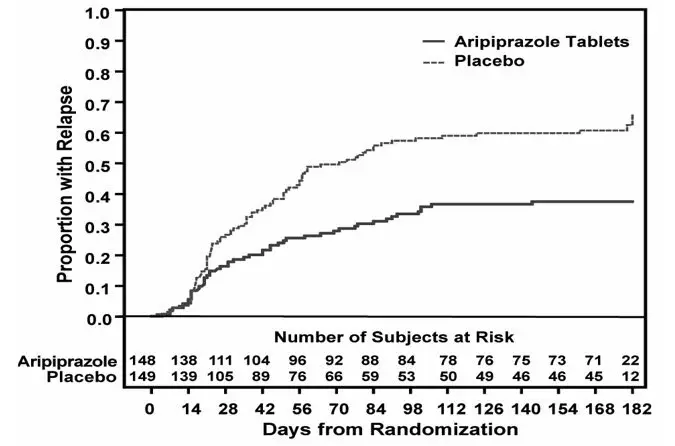
14.3 Bipolar Disorder
Acute Treatment of Manic and Mixed Episodes
Adjunctive Therapy
The efficacy of adjunctive aripiprazole tablets with concomitant lithium or valproate in the treatment of manic or mixed episodes associated with Bipolar I Disorder was established in a 6-week placebo-controlled study (n=384) with a 2-week lead-in mood stabilizer monotherapy phase in adult patients who met DSM-IV criteria for bipolar I disorder. This study included patients with manic or mixed episodes and with or without psychotic features.
Patients were initiated on open-label lithium (0.6 to 1.0 mEq/L) or valproate (50 to 125 mcg/mL) at therapeutic serum levels and remained on stable doses for 2 weeks. At the end of 2 weeks, patients demonstrating inadequate response (Y-MRS total score ≥16 and ≤25% improvement on the Y-MRS total score) to lithium or valproate were randomized to receive either aripiprazole tablets (15 mg/day or an increase to 30 mg/day as early as Day 7) or placebo as adjunctive therapy with open-label lithium or valproate. In the 6-week placebo-controlled phase, adjunctive aripiprazole tablets starting at 15 mg/day with concomitant lithium or valproate (in a therapeutic range of 0.6 to 1.0 mEq/L or 50 to 125 mcg/mL, respectively) was superior to lithium or valproate with adjunctive placebo in the reduction of the Y-MRS total score (Study 5 in Table 15) and CGI-BP Severity of Illness score (mania). Seventy-one percent of the patients coadministered valproate and 62% of the patients coadministered lithium were on 15 mg/day at 6-week endpoint.
| Study Number | Treatment Group | Primary Efficacy Measure: Y-MRS | ||
|---|---|---|---|---|
| Mean Baseline Score (SD) | LS Mean Change from Baseline (SE) | Placebo-subtracted Difference* (95% CI) | ||
| SD: standard deviation; SE: standard error; LS Mean: least-squares mean; CI: unadjusted confidence interval. | ||||
|
||||
| Study 1 | Aripiprazole tablets (30/15 mg/day)† | 29.0 (5.9) | -12.52 (1.05) | -5.33 (-7.90, -2.76) |
| Placebo | 28.5 (4.6) | -7.19 (1.07) | -- | |
| Study 2 | Aripiprazole tablets (30/15 mg/day)† | 27.8 (5.7) | -8.15 (1.23) | -4.80 (-7.80, -1.80) |
| Placebo | 29.1 (6.9) | -3.35 (1.22) | -- | |
| Study 3 | Aripiprazole tablets (15 to 30 mg/day)† | 28.5 (5.6) | -12.64 (0.84) | -3.63 (-5.75, -1.51) |
| Placebo | 28.9 (5.9) | 9.01 (0.81) | -- | |
| Study 4 | Aripiprazole tablets (15 to 30 mg/day)† | 28.0 (5.8) | -11.98 (0.80) | -2.28 (-4.44 , -0.11) |
| Placebo | 28.3 (5.8) | -9.70 (0.83) | -- | |
| Study 5 | Aripiprazole tablets (15 or 30 mg/day)† + Lithium/Valproate | 23.2 (5.7) | -13.31 (0.50) | -2.62 (-4.29 , -0.95) |
| Placebo + Lithium/Valproate | 23.0 (4.9) | -10.70 (0.69) | -- | |
14.4 Adjunctive Treatment of Adults with Major Depressive Disorder
The efficacy of aripiprazole tablets in the adjunctive treatment of major depressive disorder (MDD) was demonstrated in two short-term (6-week), placebo-controlled trials of adult patients meeting DSM-IV criteria for MDD who had had an inadequate response to prior antidepressant therapy (1 to 3 courses) in the current episode and who had also demonstrated an inadequate response to 8 weeks of prospective antidepressant therapy (paroxetine extended-release, venlafaxine extended-release, fluoxetine, escitalopram, or sertraline). Inadequate response for prospective treatment was defined as less than 50% improvement on the 17-item version of the Hamilton Depression Rating Scale (HAMD17), minimal HAMD17 score of 14, and a Clinical Global Impressions Improvement rating of no better than minimal improvement. Inadequate response to prior treatment was defined as less than 50% improvement as perceived by the patient after a minimum of 6 weeks of antidepressant therapy at or above the minimal effective dose.
The primary instrument used for assessing depressive symptoms was the Montgomery-Asberg Depression Rating Scale (MADRS), a 10-item clinician-rated scale used to assess the degree of depressive symptomatology. The key secondary instrument was the Sheehan Disability Scale (SDS), a 3-item self-rated instrument used to assess the impact of depression on three domains of functioning with each item scored from 0 (not at all) to 10 (extreme).
In the two trials (n=381, n=362), aripiprazole tablets were superior to placebo in reducing mean MADRS total scores (Studies 1, 2 in Table 16). In one study, aripiprazole tablets were also superior to placebo in reducing the mean SDS score.
In both trials, patients received aripiprazole tablets adjunctive to antidepressants at a dose of 5 mg/day. Based on tolerability and efficacy, doses could be adjusted by 5 mg increments, one week apart. Allowable doses were: 2, 5, 10, 15 mg/day, and for patients who were not on potent CYP2D6 inhibitors fluoxetine and paroxetine, 20 mg/day. The mean final dose at the end point for the two trials was 10.7 and 11.4 mg/day.
An examination of population subgroups did not reveal evidence of differential response based on age, choice of prospective antidepressant, or race. With regards to gender, a smaller mean reduction on the MADRS total score was seen in males than in females.
| Study Number | Treatment Group | Primary Efficacy Measure: MADRS | ||
|---|---|---|---|---|
| Mean Baseline Score (SD) | LS Mean Change from Baseline (SE) | Placebo-subtracted Difference* (95% CI) | ||
| SD: standard deviation; SE: standard error; LS Mean: least-squares mean; CI: unadjusted confidence interval. | ||||
|
||||
| Study 1 | Aripiprazole tablets (5 to 20 mg/day)† + Antidepressant | 25.2 (6.2) | -8.49 (0.66) | -2.84 (-4.53, -1.15) |
| Placebo + Antidepressant | 27.0 (5.5) | -5.65 (0.64) | -- | |
| Study 2 | Aripiprazole tablets (5 to 20 mg/day)† + Antidepressant | 26.0 (6.0) | -8.78 (0.63) | -3.01 (-4.66, -1.37) |
| Placebo + Antidepressant | 26.0 (6.5) | -5.77 (0.67) | -- | |
16. How is Abilify Mycite supplied
16.1 How Supplied
The ABILIFY MYCITE kit contains aripiprazole tablets embedded with an Ingestible Event Marker (IEM) sensor co-packaged with MYCITE Patches (wearable sensors) (referred to as the patch). The patch is available as a:
- 2-component patch, comprised of a removable electronics module (referred to as the "pod") and an adhesive "strip" (see Table 18 and Figure 9). The pod contains electronic components to record drug ingestion information and transfer the data to a compatible smartphone. The 30 Day Starter kits contain (a) aripiprazole tablets with sensor, (b) strips, and (c) one pod; whereas, the Maintenance kits contain (a) aripiprazole tablets with sensor and (b) strips [see Dosage and Administration (2.2)].
The patch has a corresponding IFU within the app. The status of the patch is indicated by a status icon in the app to inform the user that the patch is properly adhered and fully functioning.
Figure 9: MYCITE Patch (2-component)
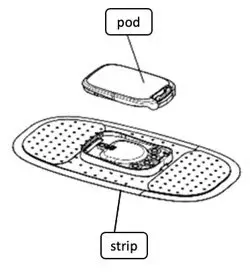 | Assembled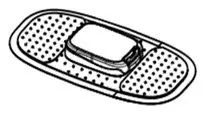 |
ABILIFY MYCITE Kits (2-component patch)
ABILIFY MYCITE kits are available in the following strengths and packages:
| Strength | Color/ Shape | Markings | Pack Size and Components (2-component patch)* | NDC Code |
|---|---|---|---|---|
|
||||
| 2 mg | pale green modified rectangle | "DA-029" and "2" | 30 Day Starter kit: Bottle of 30 tablets with sensor + 1 MYCITE pod and 7 MYCITE strips | 59148-029-61 |
| Maintenance kit: Bottle of 30 tablets with sensor + 7 MYCITE strips* | 59148-029-72 | |||
| 5 mg | pale blue modified rectangle | "DA-030 and "5" | 30 Day Starter kit: Bottle of 30 tablets with sensor + 1 MYCITE pod and 7 MYCITE strips | 59148-030-61 |
| Maintenance kit: Bottle of 30 tablets with sensor + 7 MYCITE strips* | 59148-030-72 | |||
| 10 mg | off-white to pale pink modified rectangle | "DA-031" and "10" | 30 Day Starter kit: Bottle of 30 tablets with sensor + 1 MYCITE pod and 7 MYCITE strips | 59148-031-61 |
| Maintenance kit: Bottle of 30 tablets with sensor + 7 MYCITE strips* | 59148-031-72 | |||
| 15 mg | pale yellow round | "DA-032" and "15" | 30 Day Starter kit: Bottle of 30 tablets with sensor + 1 MYCITE pod and 7 MYCITE strips | 59148-032-61 |
| Maintenance kit: Bottle of 30 tablets with sensor + 7 MYCITE strips* | 59148-032-72 | |||
| 20 mg | white to pale yellowish white round | "DA-033" and "20" | 30 Day Starter kit: Bottle of 30 tablets with sensor + 1 MYCITE pod and 7 MYCITE strips | 59148-033-61 |
| Maintenance kit: Bottle of 30 tablets with sensor + 7 MYCITE strips* | 59148-033-72 | |||
| 30 mg | off-white to pale pink round | "DA-034" and "30" | 30 Day Starter kit: Bottle of 30 tablets with sensor + 1 MYCITE pod and 7 MYCITE strips | 59148-034-61 |
| Maintenance kit: Bottle of 30 tablets with sensor + 7 MYCITE strips* | 59148-034-72 | |||
17. Patient Counseling Information
Advise the patient to read the FDA-approved patient labeling (Medication Guide).
| This Medication Guide has been approved by the U.S. Food and Drug Administration. | Revised: 12/2020 |
| MEDICATION GUIDE ABILIFY MYCITE® (a BIL ĭ fī - Mi SIHYT) (aripiprazole tablets with sensor), for oral use |
|
Important:
|
|
| What is the most important information I should know about ABILIFY MYCITE? ABILIFY MYCITE may cause serious side effects, including:
|
|
| What is ABILIFY MYCITE?
ABILIFY MYCITE is a prescription medicine of aripiprazole tablets with an Ingestible Event Marker (IEM) sensor inside it used:
It is not known if ABILIFY MYCITE can improve how well you take your aripiprazole (patient compliance) or for changing your dose of aripiprazole. There may be a delay in the detection of the ABILIFY MYCITE tablet and sometimes the detection of the tablet might not happen at all. ABILIFY MYCITE is not for use as real-time or emergency monitoring. It is not known if ABILIFY MYCITE is safe or effective for use in children. |
|
| Do not take ABILIFY MYCITE if you are allergic to aripiprazole or any of the ingredients in ABILIFY MYCITE. See the end of this Medication Guide for a complete list of ingredients in ABILIFY MYCITE. | |
Before taking ABILIFY MYCITE, tell your healthcare provider about all your medical conditions, including if you:
ABILIFY MYCITE and other medicines may affect each other causing possible serious side effects. ABILIFY MYCITE may affect the way other medicines work, and other medicines may affect how ABILIFY MYCITE works. Your healthcare provider can tell you if it is safe to take ABILIFY MYCITE with your other medicines. Do not start or stop any other medicines during treatment with ABILIFY MYCITE without talking to your healthcare provider first. Know the medicines you take. Keep a list of your medicines to show your healthcare provider and pharmacist when you get a new medicine. |
|
How should I take ABILIFY MYCITE?
|
|
What should I avoid while taking ABILIFY MYCITE?
|
|
| What are the possible side effects of ABILIFY MYCITE? ABILIFY MYCITE may cause serious side effects, including:
Call your doctor for medical advice about side effects. You may report side effects to FDA at 1-800-FDA-1088. |
|
How should I store ABILIFY MYCITE?
|
|
| General information about the safe and effective use of ABILIFY MYCITE.
Medicines are sometimes prescribed for purposes other than those listed in a Medication Guide. Do not use ABILIFY MYCITE for a condition for which it was not prescribed. Do not give ABILIFY MYCITE to other people, even if they have the same symptoms you have. It may harm them. You can ask your healthcare provider or pharmacist for information about ABILIFY MYCITE that was written for healthcare professionals. |
|
| What are the ingredients in ABILIFY MYCITE? Active ingredient: aripiprazole Inactive ingredients: cornstarch, hydroxypropyl cellulose, lactose monohydrate, magnesium stearate, and microcrystalline cellulose, and Ingestible Event Marker (IEM). Colorants include ferric oxide (yellow or red) and FD&C Blue No. 2 Aluminum Lake. Ingredients of the IEM include aluminum, cuprous chloride, ethyl cellulose, gold, hydroxypropyl cellulose, magnesium, silicon, silicon dioxide, silicon nitride, titanium-tungsten, titanium and triethyl citrate. Manufactured by: Tablets with embedded IEM sensors Manufactured by Otsuka Pharmaceutical Co., Ltd., Tokyo, 101-8535 Japan MYCITE Patches Manufactured for Otsuka America Pharmaceutical, Inc. 3956 Point Eden Way, Hayward, CA 94545 USA Distributed and marketed by Otsuka America Pharmaceutical, Inc., Rockville, MD 20850 USA ABILIFY MYCITE® and MYCITE® are registered trademarks of Otsuka Pharmaceutical Company. ©2020, Otsuka Pharmaceutical Co., Ltd., Tokyo, 101-8535 Japan For more information about ABILIFY MYCITE go to www.abilifymycite.com or call 1-844-692-4834. |
|
01_GETTING_STARTED
|
|
|
|
|
| VO: | VO: The MyCite system works in three connected parts: the MyCite App, a two-part patch consisting of a pod and adhesive strip, and an Abilify MyCite tablet with an ingestible sensor. | VO: | VO: The Abilify MyCite Tablet sends a signal to the Patch when you swallow your medication. The Patch records when you've taken your medication, as well as your rest and activity levels. |
|
|
|
|
|
| VO: Then your patch communicates this information to the App. The App lets you view your information and share it with your healthcare provider. | VO: (cont.) | VO: This app will help you set up and use your MyCite system. First, create your account, and then follow along to complete the set-up process. | VO: |
02_PREPARING_YOUR_SKIN
|
|
|
|
|
| VO: There are four steps to prepare your patch. A series of videos will walk you through each step. Please follow these steps to ensure your MyCite system is set up correctly, starting with preparing your skin. | VO: (cont.) | VO: (cont.) | VO: Find a spot on your stomach, as shown here. |
|
|
| ||
| VO: Do not place the MyCite patch in areas where the skin is scraped, cracked, inflamed, or irritated, or in a location that overlaps the area of the most recently removed patch. If there is skin irritation, you should remove the patch. | VO: Gently clean the area with soap and water. Some men may need to trim hair in this area. |
03_OPENING_YOUR_POD_&_STRIP
|
|
|
|
|
|
VO: |
VO: Now we'll help you open your pod and adhesive strip. Together they will create your patch. |
VO: (cont.) |
VO: Inside the Abilify MyCite kit, you'll find Part 2, the pod and the strips. |
|
|
|
|
|
| VO: (cont.) | VO: Take out your pod and strip. DO NOT dispose of this Pod. You will use this Pod throughout your treatment on MyCite. Your app will prompt you each week to change your strip." | VO: Place the pod and strip on a flat surface near your phone. | VO: (cont.) |
04_PAIRING YOUR PATCH
|
|
|
|
|
|
VO: |
VO: |
VO: |
VO: Your Pod and Strip should be on a flat surface near your phone. We'll show you how to connect your patch. |
|
|
|
|
|
| VO: Insert the pod into the strip until you hear a click, then wait for the blinking green light. | VO: (cont.) | VO: This signals that the pod is inserted correctly creating your patch, and is now connected to your phone. | VO: |
05_APPLYING_YOUR_PATCH
|
|
|
|
|
| VO: | VO: And now we'll help you apply your Patch | VO: (cont.) | VO: You must place the Patch on your stomach, as shown here. |
|
|
|
|
|
| VO: Unlike other Patches you may have seen, the MyCite Patch will only work if it's placed on your stomach . Remember, the Patch does not contain any medication. | VO: If you haven't already, peel off the large piece of paper backing. Then peel off the small piece. Try not to wrinkle the Patch. | VO: Standing in a comfortable, upright position, apply the Patch over the area you've prepared on your stomach. | VO: Then, smooth out any bubbles with your fingers, like this. Keep the patch on when showering, swimming, or exercising. Put the patch in a new location each time you apply a new strip. |
06_TAKING_YOUR_TABLET
|
|
|
|
|
| VO: | VO: Inside the Abilify MyCite kit, you'll find the container labeled "Part 3 the Tablets," only the Abilify MyCite tablets will work with MyCite. | VO: | VO: Take your Abilify MyCite tablet now, unless you have already taken it today. |
|
|
|
|
|
| VO: Be sure to take it with plenty of water. | VO: Swallow your tablet whole; do not divide, crush, or chew. Remember to take your medication as prescribed by your doctor. | VO: (cont.) | VO: Once you've taken your tablet, your App will let you know when your Tablet has registered. |
|
|
|
|
|
| VO: Do not change your medication pattern or dosage based on what MyCite shows you. If you want to change your medication regimen, consult your doctor. | VO: This is your home screen on the MyCite app. | VO: Your Tablet Status appears at the top when your Abilify MyCite tablet has registered. |
|
|
|
|
|
| VO: A red Check Patch button means your patch is not working Properly. Tap the button to review your patch status and to resolve any issues, such as changing your patch every seven days. A green Patch OK button means your patch is working properly. | VO:In the upper left hand corner, you'll find the menu icon. | VO: Tap the menu icon to go to your home Menu. | VO: From the home menu select Weekly View. |
|
|
|
|
|
| VO: Here, you can view your information for current and past weeks. | VO: A green Check indicates that your tablet has been registered. An X indicates when a tablet has not registered. An exclamation point shows when more than one tablet has registered. | VO: You can also view your historical information for current or past months. |
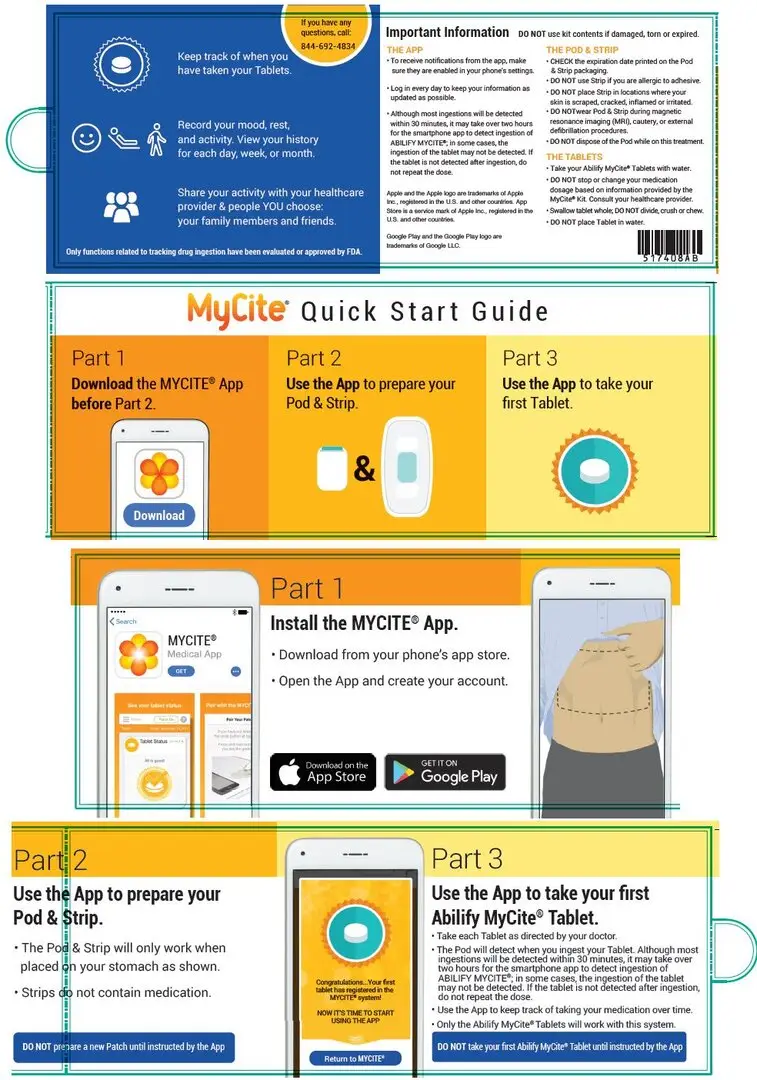
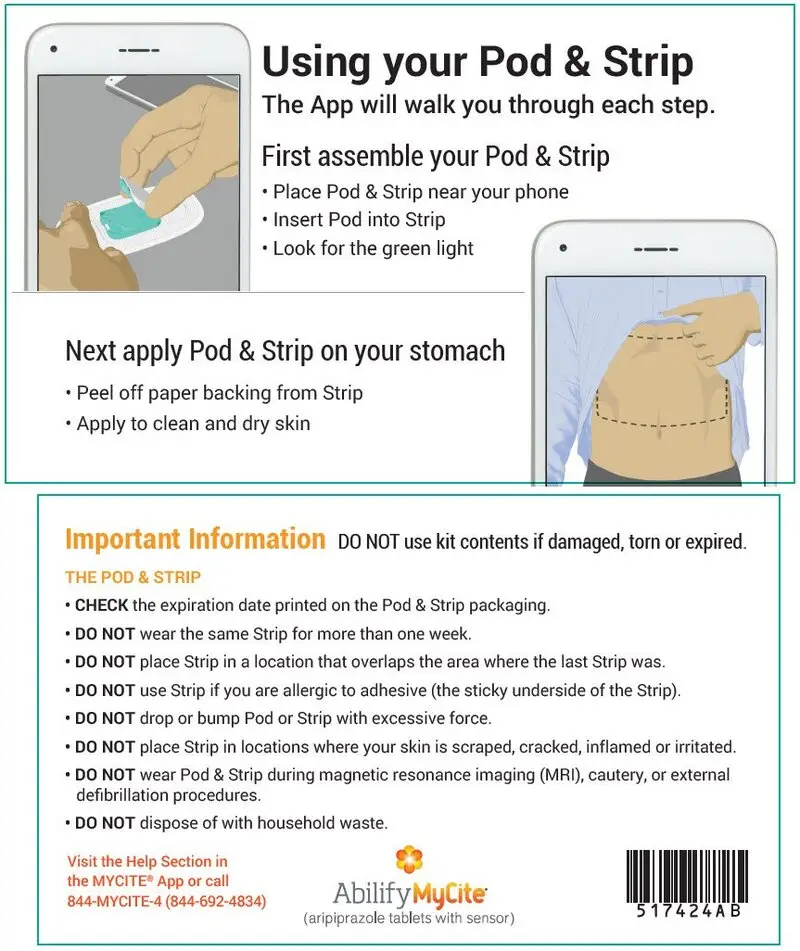
| ABILIFY MYCITE
aripiprazole tablet with sensor |
||||||||||||||||||||||||||||||||||||||||||||||||||
|
||||||||||||||||||||||||||||||||||||||||||||||||||
|
||||||||||||||||||||||||||||||||||||||||||||||||||
|
||||||||||||||||||||||||||||||||||||||||||||||||||
|
||||||||||||||||||||||||||||||||||||||||||||||||||
|
||||||||||||||||||||||||||||||||||||||||||||||||||
|
||||||||||||||||||||||||||||||||||||||||||||||||||
| ABILIFY MYCITE
aripiprazole tablet with sensor |
||||||||||||||||||||||||||||||||||||||||||||||||||
|
||||||||||||||||||||||||||||||||||||||||||||||||||
|
||||||||||||||||||||||||||||||||||||||||||||||||||
|
||||||||||||||||||||||||||||||||||||||||||||||||||
|
||||||||||||||||||||||||||||||||||||||||||||||||||
|
||||||||||||||||||||||||||||||||||||||||||||||||||
|
||||||||||||||||||||||||||||||||||||||||||||||||||
| ABILIFY MYCITE
aripiprazole tablet with sensor |
||||||||||||||||||||||||||||||||||||||||||||||||||
|
||||||||||||||||||||||||||||||||||||||||||||||||||
|
||||||||||||||||||||||||||||||||||||||||||||||||||
|
||||||||||||||||||||||||||||||||||||||||||||||||||
|
||||||||||||||||||||||||||||||||||||||||||||||||||
|
||||||||||||||||||||||||||||||||||||||||||||||||||
|
||||||||||||||||||||||||||||||||||||||||||||||||||
| ABILIFY MYCITE
aripiprazole tablet with sensor |
||||||||||||||||||||||||||||||||||||||||||||||||||
|
||||||||||||||||||||||||||||||||||||||||||||||||||
|
||||||||||||||||||||||||||||||||||||||||||||||||||
|
||||||||||||||||||||||||||||||||||||||||||||||||||
|
||||||||||||||||||||||||||||||||||||||||||||||||||
|
||||||||||||||||||||||||||||||||||||||||||||||||||
|
||||||||||||||||||||||||||||||||||||||||||||||||||
| ABILIFY MYCITE
aripiprazole tablet with sensor |
||||||||||||||||||||||||||||||||||||||||||||||||||
|
||||||||||||||||||||||||||||||||||||||||||||||||||
|
||||||||||||||||||||||||||||||||||||||||||||||||||
|
||||||||||||||||||||||||||||||||||||||||||||||||||
|
||||||||||||||||||||||||||||||||||||||||||||||||||
|
||||||||||||||||||||||||||||||||||||||||||||||||||
|
||||||||||||||||||||||||||||||||||||||||||||||||||
| ABILIFY MYCITE
aripiprazole tablet with sensor |
||||||||||||||||||||||||||||||||||||||||||||||||||
|
||||||||||||||||||||||||||||||||||||||||||||||||||
|
||||||||||||||||||||||||||||||||||||||||||||||||||
|
||||||||||||||||||||||||||||||||||||||||||||||||||
|
||||||||||||||||||||||||||||||||||||||||||||||||||
|
||||||||||||||||||||||||||||||||||||||||||||||||||
|
||||||||||||||||||||||||||||||||||||||||||||||||||
| Labeler - Otsuka America Pharmaceutical, Inc. (008314390) |




